#dortmund metro station
Text

ph. Danko Maksimovic - Dortmund, Germany (2023)
Film: Kodak Portra 800
517 notes
·
View notes
Text
Fifth Week
Hi, my name is Robert Laskarzewski, and I am currently a sophomore at the Darla Moore School of Business studying International Business and Marketing. I’m a part of the International Business Responsible International Leadership (RIL) program and will spend the Spring and Fall semesters at the ESSEC Cergy campus. I was born and raised in California, about an hour away from San Francisco. I chose to attend the University of South Carolina specifically because of the RIL program and the amount of time abroad that was offered. Once I was accepted, it was an easy choice to choose to pursue my studies there.
Saturday the 28th, I woke up early so that I was able to catch my train to Dusseldorf. The two things I wanted to see were the Dusseldorf boat show, one of the world’s largest boat shows, and a soccer game between Bayer Leverkusen and Borussia Dortmund, two renowned German soccer teams.
My train was due to leave at 10 AM, so I was sure to leave by no later than 8. There ended up being some problems with the Paris metro, so I had to reroute and take a slightly different route into the Gare du Nord.
Once I got to the train station, I patronized the stores inside and settled on a magazine for the train. I boarded my train and settled in for the roughly 4 hour train ride to Dusseldorf, passing through Brussels, Liege, Aachen, and Cologne. I was greeted by aging infrastructure and industry on my way into Dusseldorf (which didn’t fill me with confidence). Once I got out of the train station, I was able to get a good look at the city of Dusseldorf, a rather busy city with lots of history. My first objective was to eat some real German food at a restaurant called Heimwerk Altstadt in the old section of Dusseldorf (Altstadt meaning “old town”). After a filling meal of carbohydrates, I went back to my hotel room and had a good night of sleep.
The following day, I took a train to the convention center where I would see hundreds of boats and boat related products. I was even able to see some larger yachts that I had never previously had the chance to see or step foot on. In total, there were more than 15 buildings that held different exhibitions and seminars. After spending a few hours there, I went back to my room to rest a little before going to the soccer game between Leverkusen and Dortmund. As I stood on my train, I watched as we passed the BayArena stadium – and didn’t stop at the Leverkusen Mitte station, the stop I was supposed to get off at. The train wouldn’t stop for another 5 or 10 minutes leaving me all the way in the next city, Cologne. After spending 30 seconds to admire the huge cathedral in the center of Cologne, I took a cab to the stadium where I was greeted with a thundering chant that could be heard from far outside the stadium.
Monday, I woke up early so that I could catch my train back home into Paris. The journey home was uneventful.
Tuesday, I had my classes online due to train strikes in France. One of these classes is called “People & Organizations” the other was “E-Business”. This day in People & Organizations we discussed how management should operate to ensure their employees are actually motivated and engaged as well as how important these things actually are for a functioning business. In my E-Business class we discussed how IT infrastructure plays its importance in business today as such a large part of business now involves huge amounts of data and internal storage.
Wednesday, I had just my EU history class (European Kaleidoscope), a class that I enjoy thoroughly. We went over the institutions of the European Union as well as how they function to operate in synchrony with one another (ideally). On Thursday, I had my French language and culture classes.
Friday, I had my responsible marketing class where we discussed the dangers of companies “dedicating” their profits to a good cause. For example, a company may declare that they are “carbon neutral” although this can just be a buzz word which really has no effects. Furthermore, we worked on group work for cases assigned by companies, for example my group has to work on a case about sustainability from Longchamp’s (others include Biotherm, Adidas, and ESSEC itself).
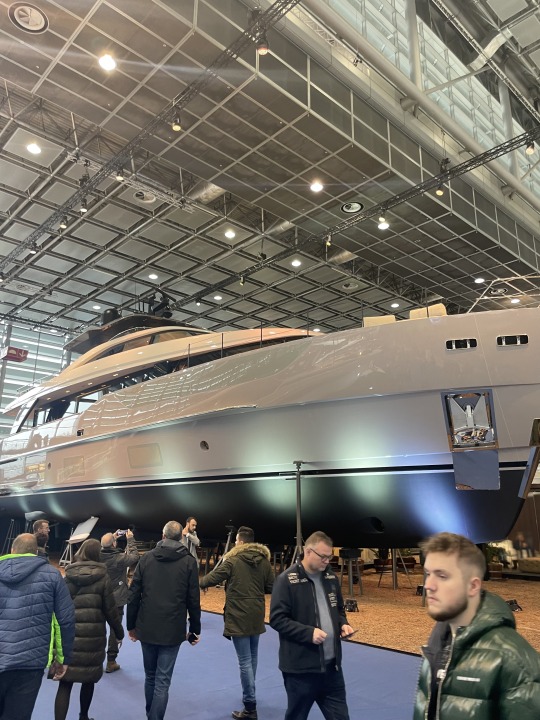

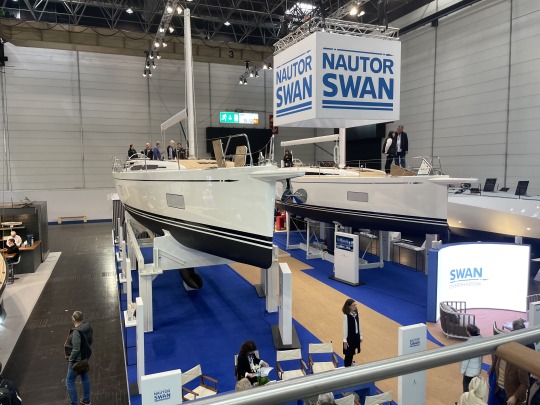

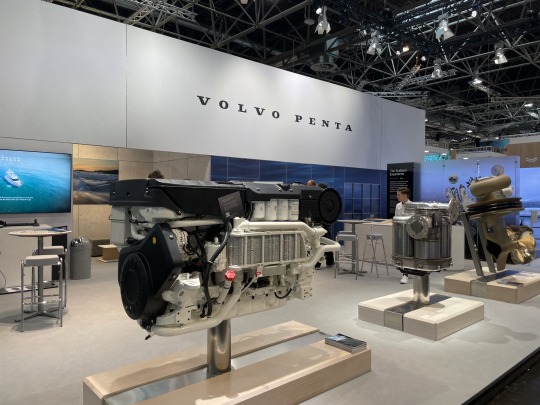
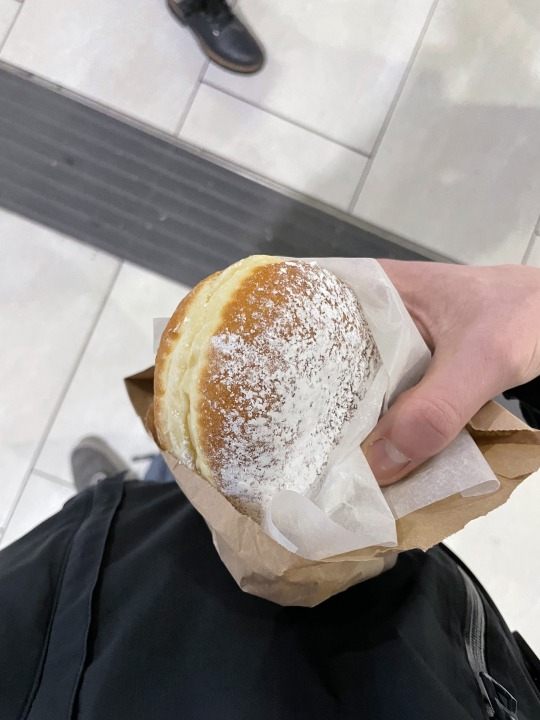

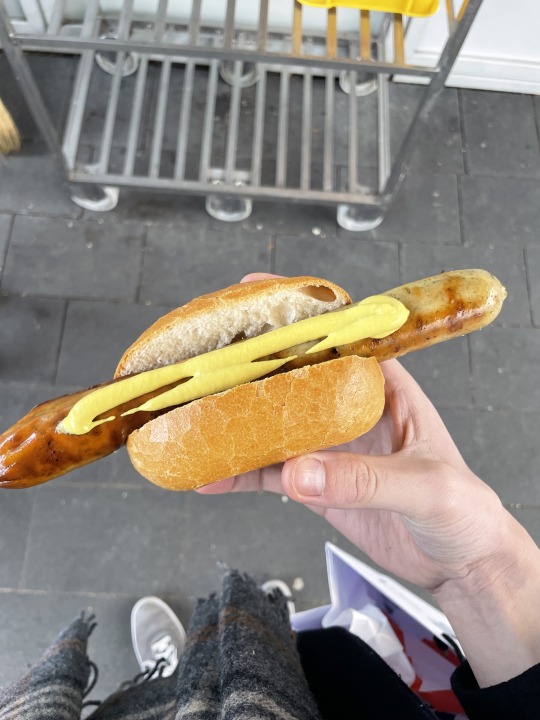

Sheep video on the bank of Rhine river
1 note
·
View note
Text
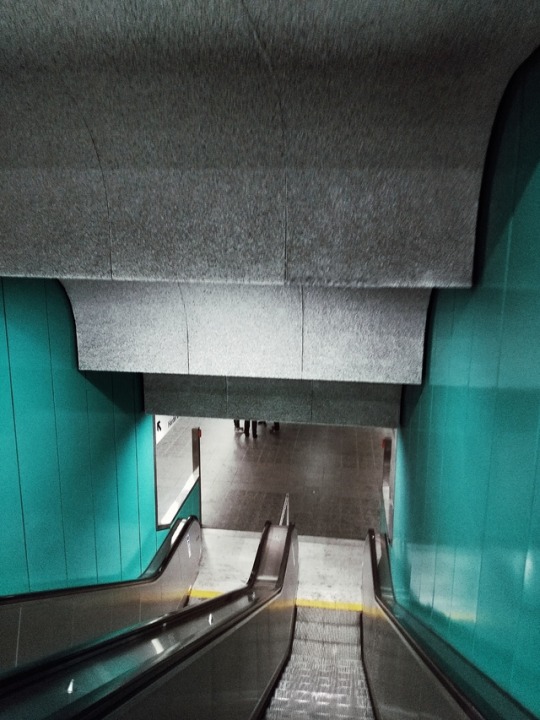
#photographers on tumblr#original photographers#snapseed#ruhrpott#ruhrgebiet#dortmund#original content#photography#architecture#train station#station#metro#light#stairs#escalator#hörde
15 notes
·
View notes
Text
Days 161-162: Munich
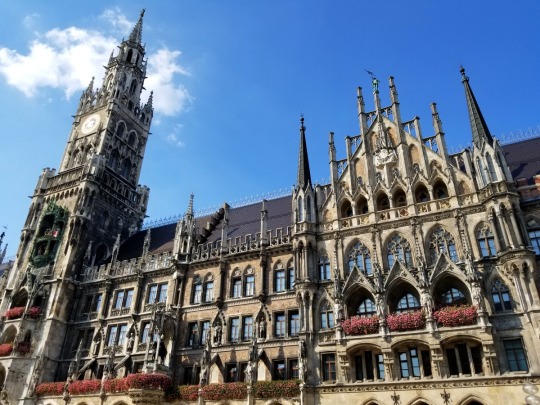
Two days after our brief dip into Germany, we dove in for good. Or for a couple weeks, at least.
Once again, we made it to our train with time to spare, but we had to split up anyway because almost all of the seats were reserved. Luckily it wasn’t a very long ride (less than two hours), but we vowed--not for the first or last time--to definitely get reserved seats for all of our long-haul rides in the future (spoiler: we didn't).

Our arrival in Munich went perfectly. We weren’t in any hurry, the weather was nice, we got some tasty sandwiches from one of the many appetizing eateries in the station, and when we found a ticket machine to buy our local transit passes, a couple stopped us and gave us their day pass that they didn’t need anymore. It was only good for the rest of that day, but definitely added to the day’s positive vibes.
We found our tram right where it was supposed to be, and half an hour later we were checked into our flat. It isn’t huge, but it’s much bigger than in Prague or Salzburg, and it’s below ground level. Meaning that it stays nice and cool during the daytime.
Not that we’ll be staying home all that much. We have a lot planned for our week in Munich, and we’re looking forward to all of it.
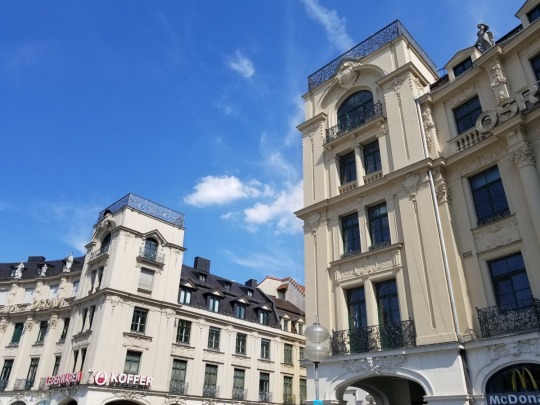

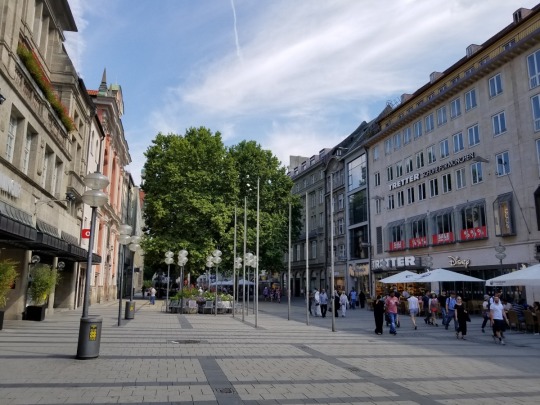
With most of the afternoon still ahead of us--and a free transit pass in our pockets--we decided to head back into town and wander about. We would need to head that way anyway if we wanted anything for dinner, since all the supermarkets in our suburb were closed for Sunday.
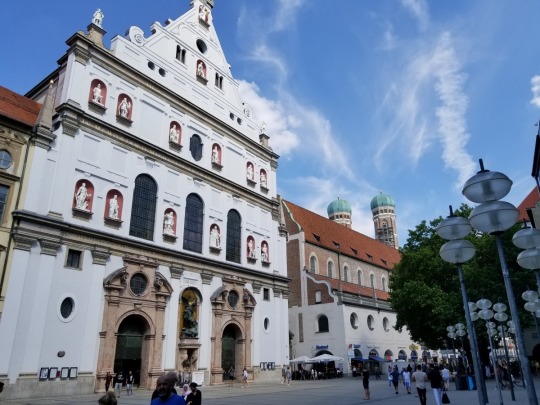

Munich suffered horribly during World War II. Almost all of the city center was damaged or destroyed by Allied bombing. But afterwards, the city worked hard to rebuild itself as closely as possible to what it had been before the bombs fell.
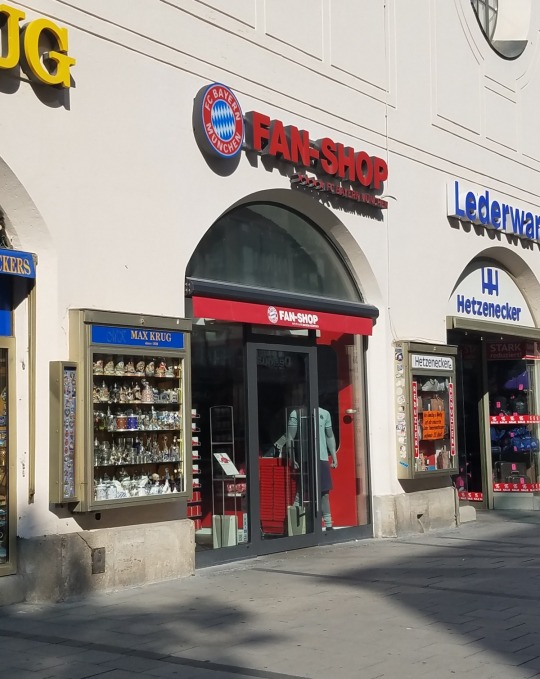

Jessica of course noticed the Bayern Munich FC store, and we found a display window full of cuckoo clocks. (I should clarify that Jessica is not a Bayern Munich fan; she roots for Dortmund in the Bundesliga.)
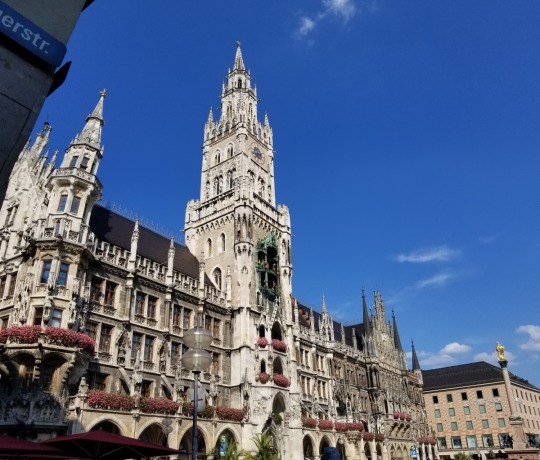
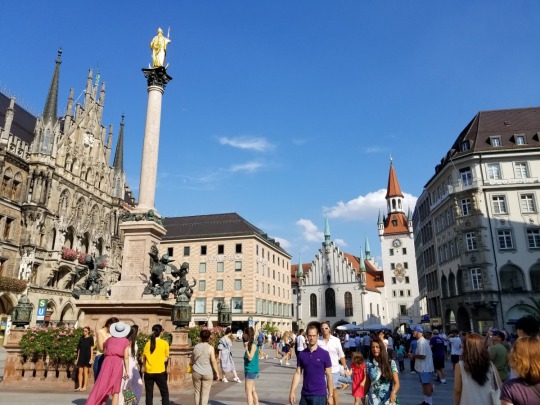
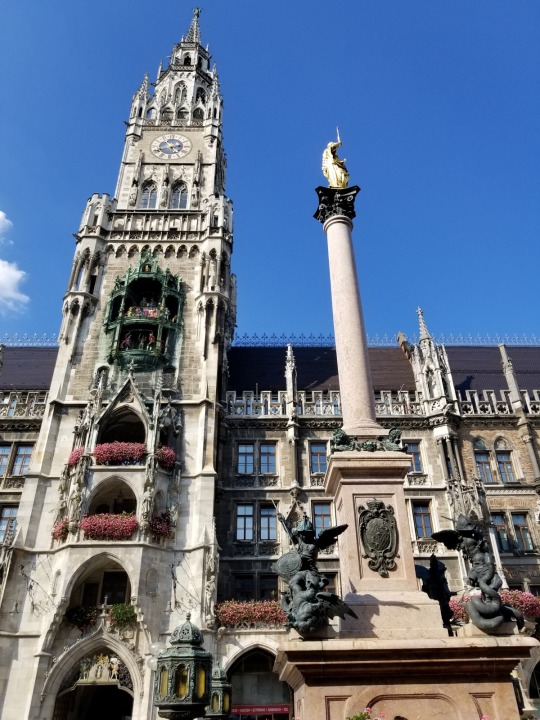
After stopping for some rest and refreshment at a street-side café, we continued on to Marienplaz, the square that has served as the historic heart of Munich for the past thousand years. It is named for the Virgin Mary, and a brilliantly polished gold statue of Mary stands at its center. Along the entire north side of the square is the spectacular Neo-Gothic New Town Hall, which was built in the late 1800s.
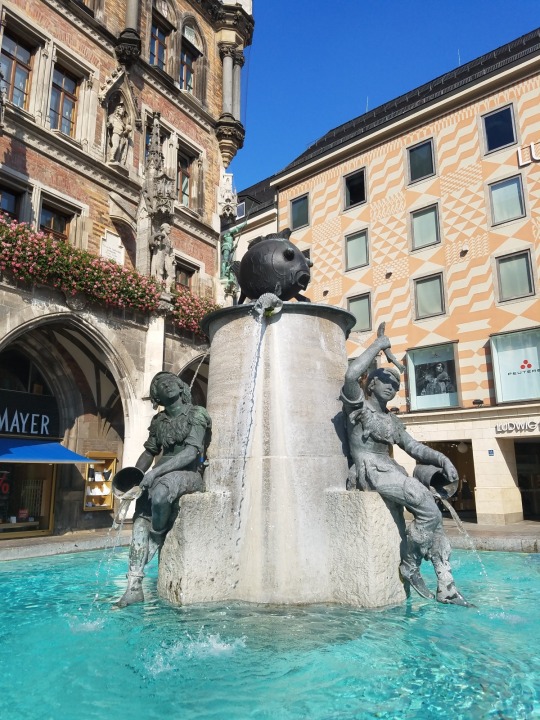
In one corner of the square is a fountain with a giant fish on it. We learned later that although this fountain was made after WWII, there has been a fountain in this spot since the 1300s, and the local fishmongers would actually keep their fish in it during market days.

By pure chance, we arrived just before 5:00 pm, when the New Town Hall’s bell tower glockenspiel show performs every afternoon. The performance lasts around ten minutes and includes bell chimes and dozens of revolving figures. They dance, joust, and feast in celebration of a real-life wedding that took place in Marienplaz in the 1500s.
(Also, Jessica and I still can’t help but be amused that the German word for town hall is Rathaus.)
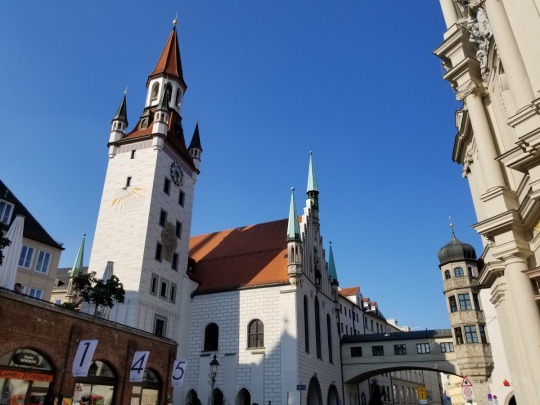
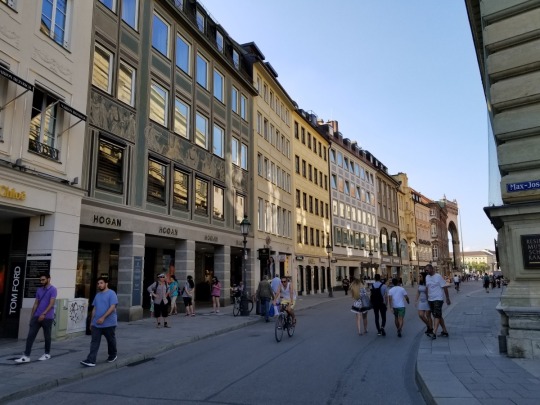
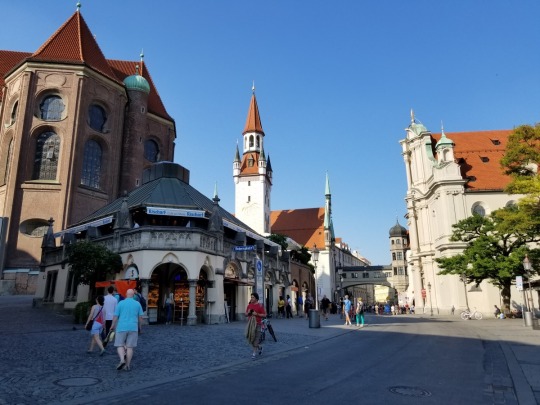
Once the show was over, we simply walked around the old town for a little while longer. We saw some charming window displays in closed shops, the closed up food market, and the Old Town Hall. Even though pretty much everything was closed for Sunday, there was an intoxicatingly pleasant atmosphere about the place. And it wasn't just the beer everyone was drinking, or even that it was the coolest afternoon we’ve experienced since leaving Scotland.
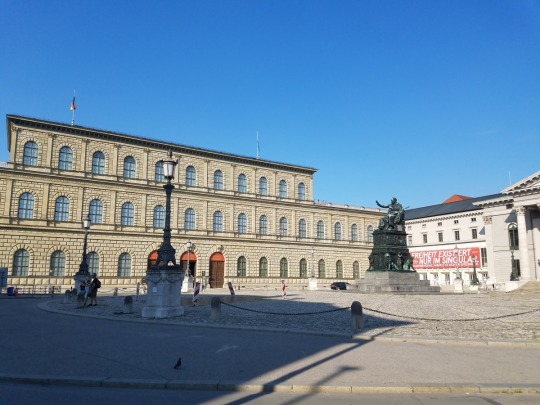
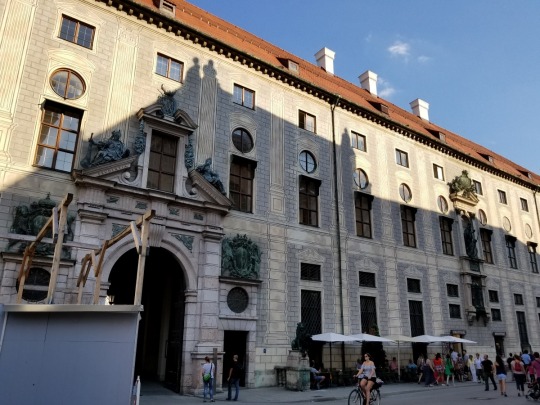
Our wanderings eventually took us to the Munich National Theatre and Royal Residence, which gets to be called a royal residence because Bavaria was technically a kingdom for about a hundred years out of its much longer history as a German duchy and principality.
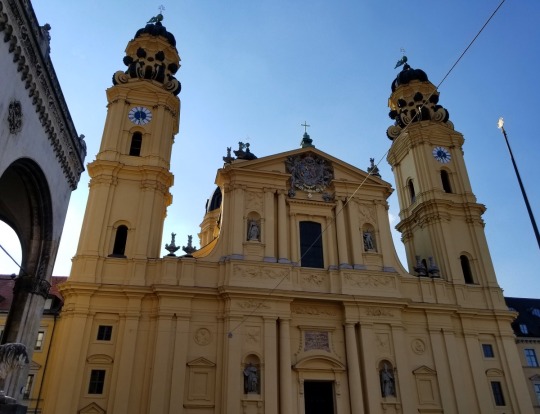

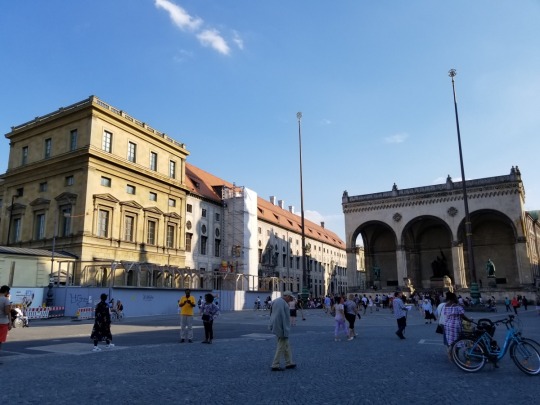
Between the Residence and the impressively yellow Theatrine Church is the Odeonsplatz, which was easy for us to remember because Odeon is also the name of major chain of movie theaters in the UK. The square also held a massive, statue-filled arcade--similar to the loggia in Florence. We would learn the next day that this was very much intentional and that Munich has even been called the Florence of the north.
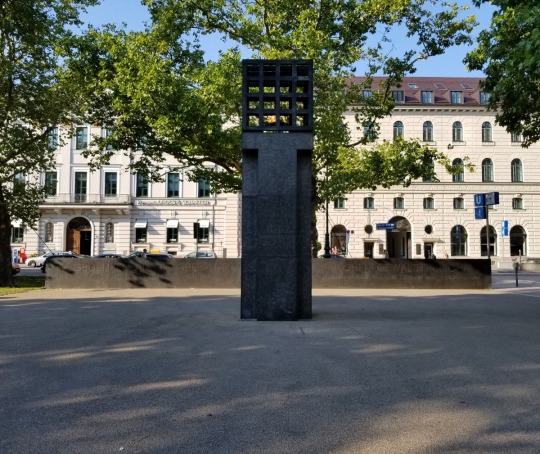
As we wound our way back toward the train station to catch a tram home, we discovered a stark stone column topped with an eternal flame. After translating the inscriptions, we learned that it is a monument to the victims of Nazi tyranny.
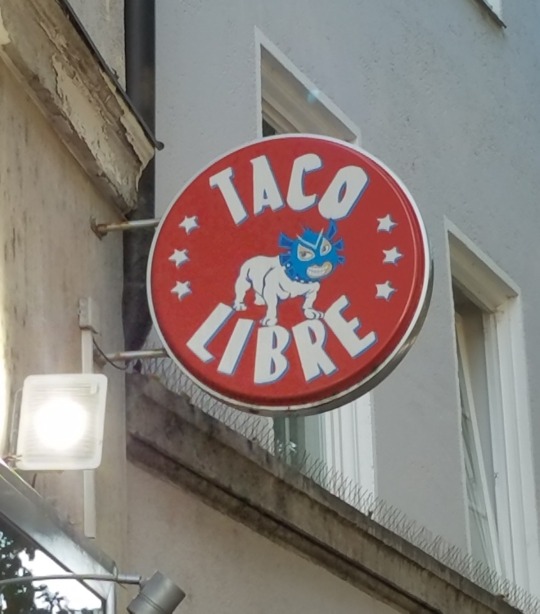
We also found an interesting-looking Mexican restaurant, but for some reason Jessica wasn't interested. We were tired, hungry, and in need of a bathroom, so we pressed on in search of a grocery store
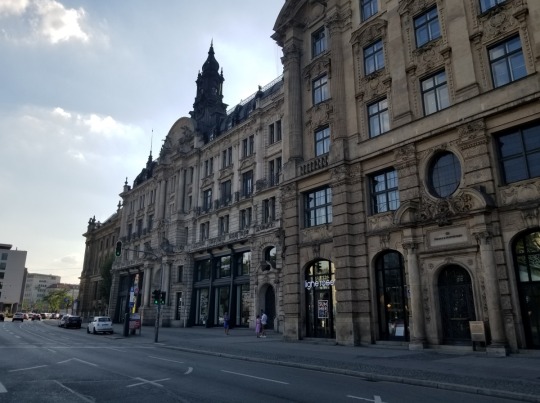
After way too long of a search in and around the central train station, we found the grocery store in the underground level connecting it to the city metro. It might have been the only one in the entire area that was open on Sunday afternoons, because it seemed like the entire city was standing in the checkout line. Seriously, the queue wrapped almost the entire way around the store and back to the entrance.
But the line moved surprisingly fast, and soon enough we were back home for a nice relaxing evening. Tomorrow, we would enjoy a guided walk through the city so that we could learn what everything we saw actually was. And we’d get to actually go into all the cool-looking shops that had been closed that day.
The next morning, we met up with our walking tour at the train station--again after a bit of slightly lost wandering. This was the first of several tours we'd booked with Radius Tours, one of two similar groups that Rick Steves recommends. We had a great time and would recommend them to anyone interested in good walking tours of Munich and nearby transit-accessible destinations like Dachau and Nuremberg.

Our tour guide was an Irish man with a golden tongue. It may just be selection bias, but almost every Irish guide we met in Europe was a natural storyteller and crowd-wrangler. There was another American woman in out tour group, and she and Jessica were instant friends.

Just outside the train station, our guide pointed out a courthouse known as the Justice Palace. It still functions as a German district court, but it is most famous as the location of the White Rose trials during WWII, in which anti-Nazi student protestors were arrested and sentenced to imprisonment or death. The trials were conducted by "People's Courts," which Hitler had empowered to condemn enemies of the regime outside the normal judicial process and without regard for constitutional rights.
The execution of peacefully protesting German students without a fair trial sent shockwaves throughout Germany and the rest of Europe. It didn't lead to any open revolts within Germany, but it was noted that people were much less inclined to report student protestors to the Gestapo after the White Rose trials took place.
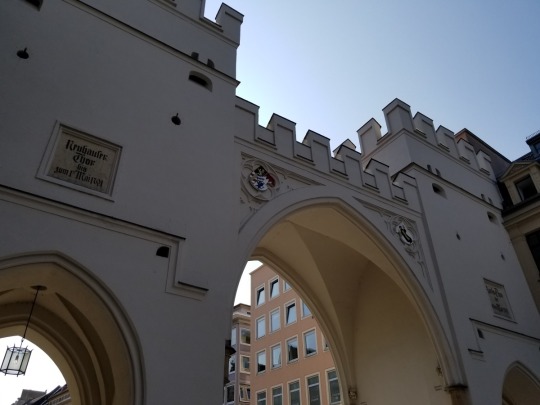
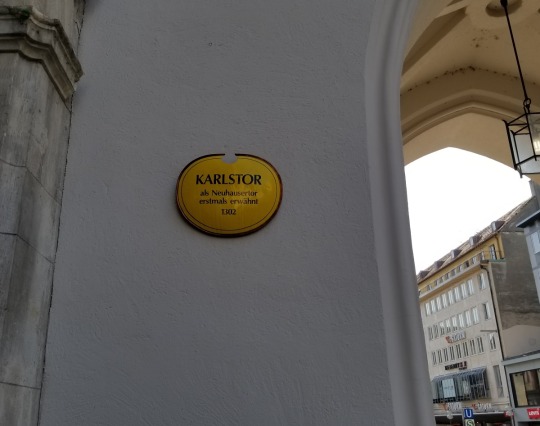
Before heading into the Old Town, we stopped for a few minutes to admire the Karlstor, one of the city's original medieval gates. Back in the day, this was the edge of a walled city surrounded by a moat. A shiny plaque proudly dates the gate to 1302, but the current structure is far younger than that. Much of the gate was destroyed in an accidental gunpowder explosion in 1857, and the subsequently restored gate has been heavily modified in the years since to accommodate increasing levels of street and pedestrian traffic.
Thanks to the 1972 Olympics, however, Munich's Old Town is now almost entirely pedestrianized.
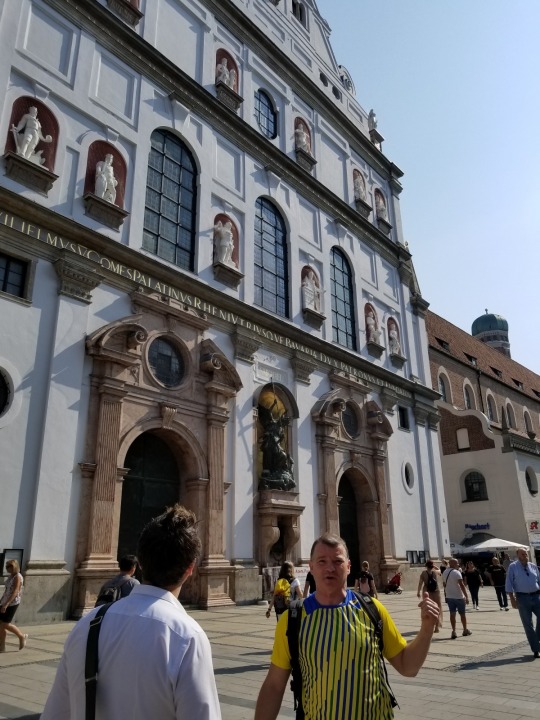

As we walked down the bustling Neuhauser Strasse from the gate to the central square, our guide pointed out the beautiful Baroque church façade we'd seen yesterday and identified it as St. Michael's, a Jesuit church. It was an important and influential church during the Counter Reformation, but today it seems mainly known for being under perpetual renovation since it was badly damaged during WWII.
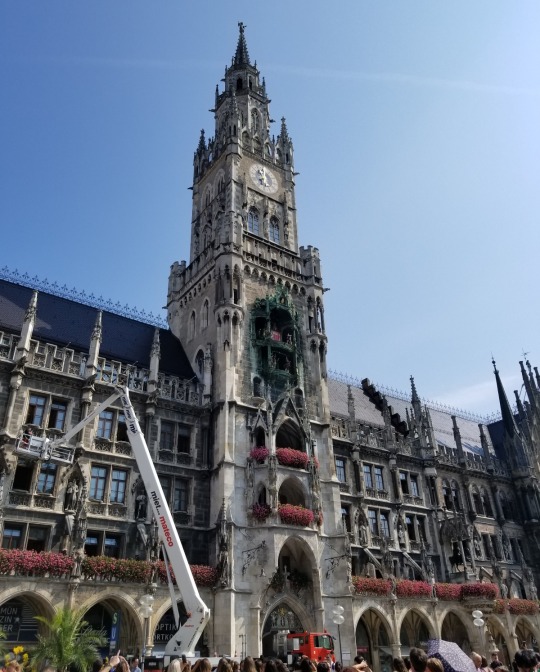
We reached Marienplatz just in time to catch the morning performance of the Glockenspiel. Our guide explained that the moving figures are actually references to two different stories in Munich's history. The top level shows a joust that took place at the wedding of Duke William V of Bavaria--the man who founded the Hofbrau as the official court brewery--to Renata of Lorraine. One of the knights is wearing Bavarian colors, and the other is wearing the colors of Lorraine (or Lothringen, as it's called in Germany). The Bavarian knight always wins.
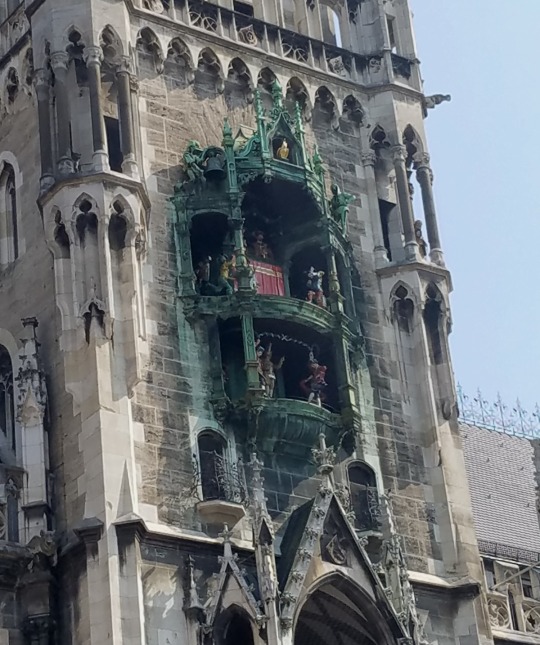
The lower tier of the display tells another story that takes place a few decades earlier during a plague year. When the city was gripped by fear and discontent, the coopers' guild got together and danced through the city to raise people's spirits and show their support for the duke. The "Coopers' Dance" has since become a symbol of perseverance and loyalty.
And as small as all of these figures look from from down in the square, all of the figures are actually life-sized.
We also learned that the New Town Hall was one of the few buildings that wasn't destroyed by the WWII bombings. Ironically, this means that the New Town Hall is actually far older than the Old Town Hall, which had to be rebuilt after the war.

We saw Munich Cathedral, also known as the Frauenkirche, which is visible from around the city with its distinctive bronze-domed bell towers. We learned that when the cathedral was constructed in the Middle Ages, Munich was just a small market town in the shadow of its much older and wealthier neighbor Freising. Over time--and thanks to some political shenanigans--Freising gradually fell under Munich's growing shadow, and today it is chiefly known as the home of Munich International Airport.
But in the 15th century, that was all still to come. Munich wasn't wealthy, so the cathedral had to be built out of bricks instead of stone. The cathedral's one extravagance was to be a pair of massive bell towers topped with sky-scrapping spires. But even that proved too much, and the builders ran out of money. So instead, they capped the bell towers with simple bronze domes to keep out the rain, and they have stood thus ever since.
As an aside, the name Frauenkirche literally translates as “Church of Our Lady,” exactly the same as the many Notre Dames scattered across France.
It was around this time that I noticed I'd somehow put my shirt on backwards that morning, and for the rest of the tour my mind was half-occupied with looking for an opportunity to fix it.

Retracing our steps from the previous day, we saw the Munich National Theater and Royal Residence. We also learned one of our favorite facts of the entire trip--right up there with Col. Shrapnel in Gibraltar.

A long section of the Residence's outer walls are flat with paintings of intricate architectural embellishments. Jessica and I had seen similar designs throughout Europe and had just assumed the day before that this was done out of a similar aesthetic style. But that's not it at all.
After the almost total destruction of central Munich during the WWII, the people of Munich were largely left to rebuild their city on their own. I had always assumed that this had been covered by Marshall Plan--an American program that lent billions of dollars to rebuild Germany and the rest of Western Europe after the war. But the Marshall Plan funds were earmarked for rebuilding Germany's industry and commerce, not its heritage. The rebuilding of all the historic structures in Munich was done with what little money the locals could put together themselves.
They did a fantastic job, but there was only so much they could do. And the Residence, with its extraordinarily ornamented architecture, was simply beyond their means. So the people of Munich did the next best thing: they painted the walls to show what the building would have looked like if they had been able to rebuild it the way it actually was.
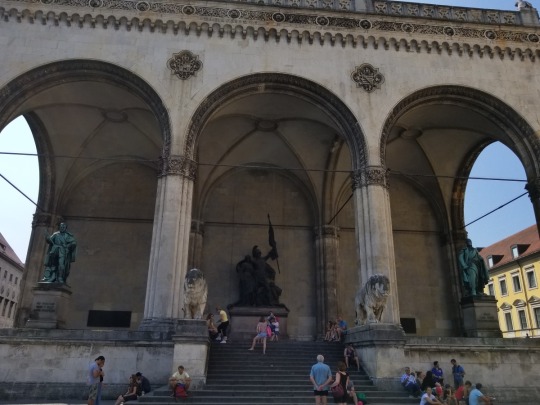
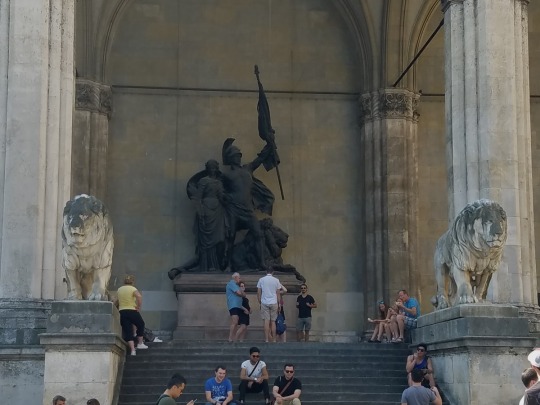
Our guide also pointed out the statue-filled loggia and confirmed that it was inspired by the one in Florence. He also pointed out the two lion statues flanking the stairs leading into it. The loggia is directly between the Residence and the Theatrine Church, and the two lions were meant to represent the co-equal powers of church and state in Bavaria.
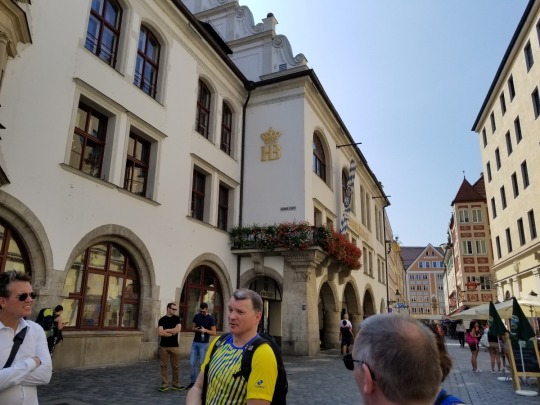

Turning back into the Old Town, we headed over to the Hofbrauhaus, the largest and most famous beer hall in Munich--as well as one of the oldest. It can seat 1,300 people at once, but for the first 250 years of its existence it was the private property of the Bavarian nobility and closed to the general public. Since 1828, however, locals and tourists alike have been filling its benches and drinking beer by the liter.
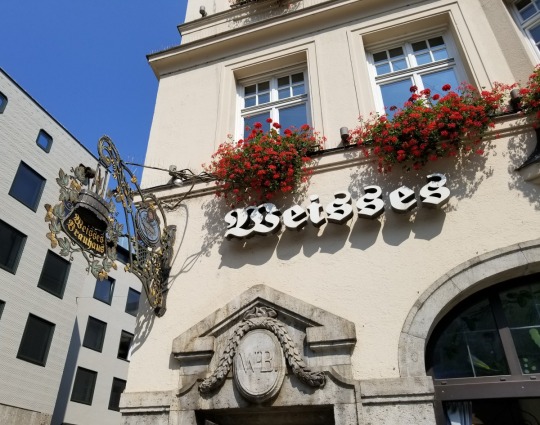
When Jessica mentioned that the main beers she enjoyed were wheat beers (hefeweizen or weissbier in Germany), our guide made sure to point out the nearby Schneider Weisse beer hall, where an unparalleled variety of weissebiers are on tap. There are seven different weissbiers in their main line, labelled "Tap 1" through "Tap 7," plus a further selection of seasonal and special-release weissebiers on tap at any given time. All are made by the family-owned Schneider & Son brewery in the nearby city of Kelheim.
Jessica's interest was thoroughly piqued. I had never particularly enjoyed wheat beers before, but I was willing to give it a try. We eventually did try it, and it was fantastic, but that's a story for a future post.
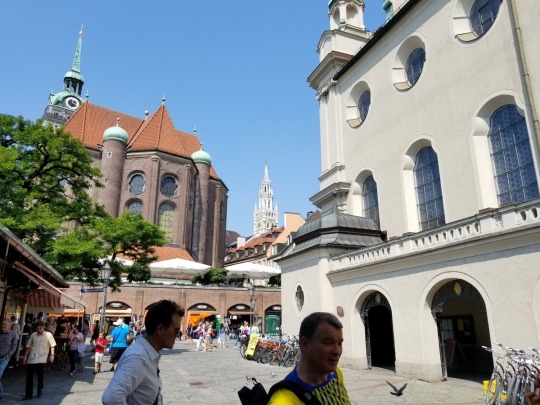
Our last stop was the Viktualienmarkt, a huge open-air food market centered around a massive beer garden. We learned that the beer garden is co-owned by the six Munich breweries, and they take turns so that all six make the same amount of profit. The current brand on tap was Spaten, which is generally considered to be the least-best of the bunch.
We also learned about Bavaria's beer garden culture. Before refrigeration was invented, beer kegs were stored in underground cellars to keep them cool, and trees were planted above the cellars for even more insulation. People soon realized that cool beer and shady trees make a perfect combination in the summer, so they started showing up at the breweries to drink beer and eat packed lunches.
When you visit the Viktualienmarkt or any other traditional beer garden, you will notice a mixture of tables with and without tablecloths. The tables with tablecloths are for traditional table service. You sit down and wait to be given a menu. But the tables without tablecloths are for the traditional picnic experience. You can get a group of friends, wander the market picking out tasty things to eat, then sit down at an unoccupied table and order a cool beer to wash it all down.
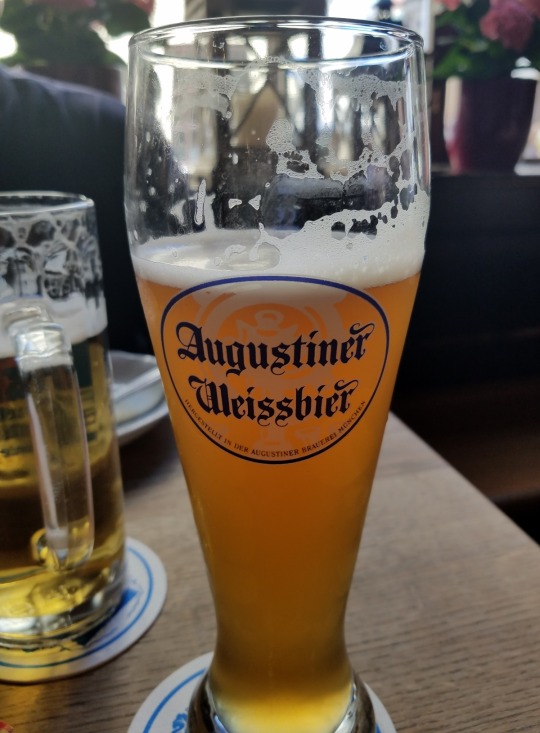
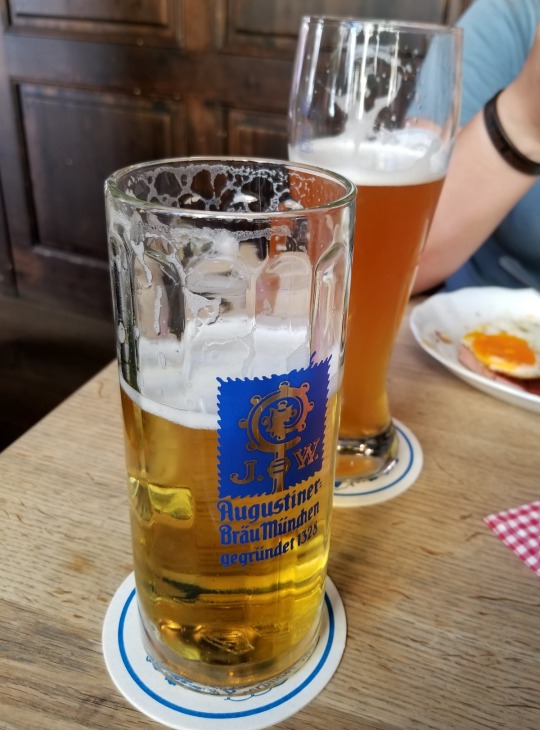
After the tour was over, went back to the Hofbrauhaus and had an excellent lunch at the nearby Augustiner restaurant. While Hofbrau is the most internationally famous Munich brewery, Augustiner is the oldest and most popular among native Münchners. While we never had a bad beer in Munich, we'll go along with the consensus that Augustiner is probably the best of the bunch. Which is sad, because they don't export their beer. It's hard to find it even in other parts of Germany.
I had their helles pale lager, and Jessica had their weissbeir. Both were top-notch.
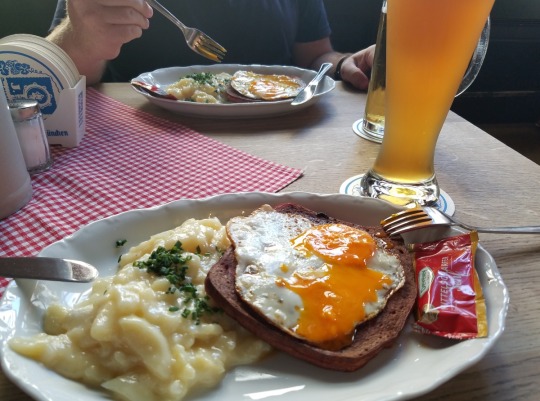
For the food portion of our lunch, we each enjoyed the beer garden staple of liberkäse--a mixed-meat sausage similar to bologna, baked into a loaf and cut into thick slices--pan fried and served under a fried egg. It also came with Bavarian potato salad, which is very different from American potato salad. It is thin and a little vinegary, but light and refreshing on a warm day.
We struck up a nice long conversation with an American guy at the next table who was doing his own extended European trip. I also took the opportunity to run to the bathroom and fix my shirt.
After lunch, we strolled around the shopping area and found a lot of stores selling cute if touristy Bavarian souvenirs. I found a nice stoneware mug that I really liked, but I decided to hold off and think about it for a bit. There was also a nice stationery store where I was severely tempted to buy a bottle of limited-edition Mont Blanc fountain pen ink that was on sale for half the price it is in the US. I didn't need it, though, and I wasn't eager to add a heavy glass bottle to my pack. Plus, I already had my sights set on some bottled inks that were waiting for me down the road in the Netherlands.
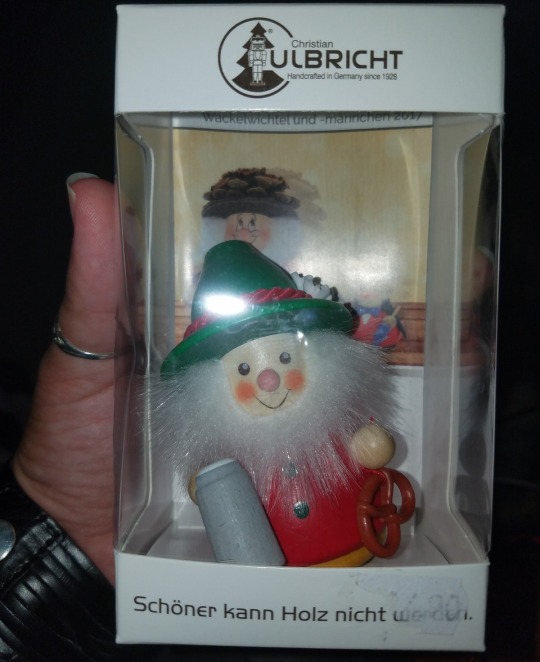
Jessica had fun too. She found a new friend at one of the aforementioned Bavarian souvenir shops, and we also found a whisky store specializing in fine Scotch. It seems almost heretical to sell Scotch in this mecca of beer, but we couldn’t resist. Jessica ended up buying a bottle of the Little Bay she’d enjoyed so much in Oban.
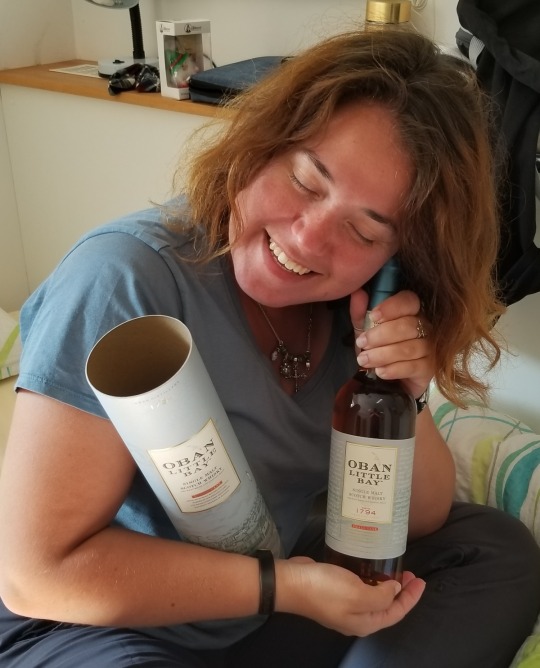
Don't worry, though--we never drank Scotch instead of German beer or wine, just in addition to it.
Yes, there was quite a lot of drinking that got done during this week, and we may have gone to bed toasted more times than not. But that didn't stop us from seeing and enjoying a ton of what Bavaria had to offer--including some sites that were truly sobering.
Next Post: Neuschwanstein (and the story of Mad King Ludwig)
Last Post: Salzburg & Berchtesgaden
1 note
·
View note
Text
The Station: Spin heads to Europe, Just Eat Takeaway gobbles up Grubhub and a drive in a Bentley Flying Spur
The Station is a weekly newsletter dedicated to all things transportation. Sign up here — just click The Station — to receive it every Saturday in your inbox.
Hi friends and first-time readers. Welcome back to The Station, a newsletter dedicated to all the present and future ways people and packages move from Point A to Point B. I’m your host Kirsten Korosec, senior transportation reporter at TechCrunch.
COVID-19 hasn’t gone away, in case you were wondering. And yet, city, county and state governments are continuing to reopen economies, some slower than others. The quiet and sleepy streets of metro areas around the world are bustling once again. Yep, congestion is back and in some areas already worse than pre-COVID. Take San Francisco, as an example. The San Francisco County Transportation Authority launched a congestion tracker that provides a week-by-week look at vehicle speeds on its network. Check it out and see how it has changed.
The photo below of a highway system in the Los Angeles area provide a reminder about how COVID-19 and the stay-at-home orders that followed decreased traffic.
Image Credits: Patrick T. Fallon/Bloomberg via Getty Images / Getty Images
We’ll be tracking in the weeks and months to come, whether cities will keep some of the pedestrian, biking, scooter friendly initiatives put in place during the COVID-related lockdowns. We expect it will be a mixed bag, and highly dependent on just how squeaky those wheels are (we’re talking about pressure from residents, activists and the business community).
One highway project worth watching is the $7 billion project to rebuild most of the Houston’s downtown freeway system and reroute and expand Interstate 45. A new impact study reveals that “158 houses, 433 apartments or condos, 486 public housing units, 340 businesses, five churches and two schools” would have to be destroyed to expand the highway, the Houston Chronicle reported.
Here’s what is worth understanding about this project, which Streetsblog notes, the buildings slated for demolition are disproportionately located in low-income communities of color, including many within the borders of Texas’s first black-formed municipality, Independence Heights. Highway projects are often viewed as signs of progress. The Interstate Highway System also decimated entire communities in the pursuit of that progress. Check out Changing Lanes: Visions and Histories of Urban Freeways for a deep dive.
Reach out and email me at [email protected] to share thoughts, criticisms, offer up opinions or tips. You can also send a direct message to me at Twitter — @kirstenkorosec.
Alright, time to dig in. Vamos.
Micromobbin’
Spin made its first foray into Europe with the launch of its electric scooters in Cologne, Germany. In the coming weeks, Spin will deploy additional scooters in Dortmund and Essen. Competitor Bird began its expansion into Europe back in August 2018, while Lime has operated electric scooters in Europe since June 2018.
Meanwhile, Wheels redeployed its scooters equipped with self-sanitizing handlebars and brake levers in Los Angeles, San Diego, Dallas, Austin and Orlando. This came after the company temporarily paused its services in March due to COVID-19. Additionally, Wheels announced a donation program to honor George Floyd. For the first eight minutes and 46 seconds of all riders’ first ride through June 17, 2020, Wheels will donate all of the proceeds to the NAACP Legal Defense Fund, the Equal Justice Initiative, Color of Change and the ACLU.
— Megan Rose Dickey
Deal of the week
This week was overflowing with unusual deals. But hey, we live in a world where the NASDAQ composite surpassed the 10,000-point milestone despite such piddling details as the U.S. economy formally being in a recession and a persistent global pandemic.
Let’s start with rental car company Hertz, which received approval Friday from a judge handling its bankruptcy to sell up to $1 billion in stock. Here are the important details. Hertz filed for Chapter 11bankruptcy protection in late May. On Thursday. Hertz made an emergency request to sell up to 246.8 million unissued shares to Jefferies LLC. A judge approved the request.
Hertz stock has been on a wild ride and the retail investors, particularly Robinhood users, appear to be the passengers in the front seat — cheering along despite the likelihood that this equity could soon be wiped out. Read more below for a deeper breakdown into the numbers.
Image Credits: Africa Studio (opens in a new window) / Shutterstock (opens in a new window)
If you’re wondering what’s cooking in the food delivery industry, I can tell you that there is only one special on the menu: consolidation with extra Sriracha. It’s getting spicy!
The latest example is Just Eat Takeaway, which reached an agreement to acquire Grubhub in the U.S. in an all-share deal for an enterprise value of $7.3 billion. The deal comes fresh off the heels of Just Eat’s merger with the Netherlands’ Takeaway.com. This tie-up is juicy, and not just because it’s a big piece of M&A in food delivery. It also resulted in a competitive swipe at Uber Eats, which had been working on and off with Grubhub for more than a year to acquire the company, according to a source familiar with the deal.
Here are the numbers: Grubhub shareholders will get 0.6710 Just Eat Takeaway.com ordinary shares in exchange for each Grubhub share, representing an implied value of $75.15 for each Grubhub share (based on the undisturbed closing price of Just Eat Takeaway.com on June 9, 2020 of €98.602). This gives Grubhub a total equity consideration (on a fully diluted basis) of $7.3 billion.
The deal caps off a tumultuous period for Grubhub, which was also created through a combination with another rival, Seamless. Keeping up? Good, you can expect more of this.
Uber might have been bitten by Grubhub, but it’s not going to skulk away from the food delivery industry. The ride-hailing business offloaded its micromobility play Jump and has doubled down on food delivery with its Eats business. Uber still sees consolidation of the food delivery industry as a path to profitability. The upshot: Uber is sniffing around for the next available candidate.
Other deals that got our attention ….
Instacart secured $225 million in a round led by DST Global and General Catalyst. Existing investor D1 Capital Partners participated in the round, which brings Instacart’s valuation to $13.7 billion.
Upstream Security secured an expansion of its Series B funding with an investment by Salesforce Ventures. The undisclosed amount is in addition to $30 million previously invested by Alliance Venture Capital (Renault, Nissan, Mitsubishi), Hyundai, Nationwide Insurance, Volvo Group and others. While the company wouldn’t share exactly how much Salesforce invested sources told us it’s in the “few millions.”
Lillium, the German startup that’s designing an all-electric vertical take-off and landing aircraft to ferry passengers within and between cities, picked up an additional $35 million in funding. The capital is an extension to a $240 million round Lilium announced in March and notably brings in Baillie Gifford, the storied Scottish venture firm that has backed the likes of Tesla and SpaceX, Spotify and Airbnb, among others.
Dr. Remo Gerber, Lilium’s chief commercial officer, confirmed in an interview that Lilium is in talks to add more to the round. That would be in line with what sources told us last year, when we reported that Lilium was looking to raise more like $400 million-plus. For those keeping track, the total raised so far is more than $375 million, at a valuation that sources very close to the company confirm is now over $1 billion.
Viaduct, a startup that uses machine learning to provide analytics on connected vehicle data, raised $11 million in Series A funding led by Innovation Endeavors and joined by Exor Seeds and Box Group. The startup, founded by CEO David Hallac, includes a mashup of machine learning academics from Stanford and Georgia Tech and former employees of Tesla, Facebook, Google Brain, Medallia and Boeing.
The software was developed to help automakers unlock all that connected vehicle data they’ve been collecting and turn it into revenue-generating services and features. The software analyzes the trove of data collected from the increasingly large number of connected vehicles so that OEMs can offer services such as predictive maintenance, personalized in-vehicle experiences and usage-based insurance.
BMW i Ventures announced an investment in Prometheus Fuels, an energy company removing CO2 from the air and turning it into zero-net carbon gasoline that it will sell at gas stations. BMW i Ventures did not disclose the amount of the investment.
Vroom, the online vehicle marketplace, raised $468 million in its IPO. The company had planned to price its IPO between $15 and $17 per share, according to the filing. But instead, it priced 21.3 million shares at $22 for fully a diluted market value of around $2.8 billion.
Vroom is another example of investors seeming to focus on growth metrics and ignoring everything else. The company’s gross margin fell from 7.1% in 2018 to 4.9% in 2019 and its net losses (not counting accretion of redeemable convertible preferred stock) rose from $85.2 million in 2018 to $143 million in 2019. Those deficits continue to rise. However, the company’s Q1 revenue grew from $235.1 million in 2019 to $375.8 million (+60%) in 2020.
What we have here is not merely another unprofitable unicorn, Alex Wilhelm wrote earlier this week after looking through the numbers. Nope, we have a very low-margin, unprofitable unicorn that is still drawing enough investor interest to raise its IPO range. The upshot? Growth is once again hot as hell.
Layoffs, business disruptions and people
This section is often dominated by layoffs. But this week, there were some notable hires.
Rivian, which last week we reported had laid off off 40 employees from its Plymouth, Michigan headquarters and hired some key executives, is back at it again. This time, Rivian has hired away a rising star at GM. Alex Archer, who was GM’s design engineer, is now working at Rivian as a design and release engineer, the Detroit Free Press reported. Archer is a 2015 Stanford University graduate who led the invention of the power sliding console that is in the 2020 models of the GMC Yukon and Yukon XL, Denali, Chevrolet Tahoe and Suburban full-size SUVs.
Cruise has not let off the throttle in its pursuit to hire as many engineers and technical experts as possible. Last week, we wrote about Cruise co-founder and CTO Kyle Vogt sending an email to employees at Zoox with a direct appeal to join his company. We’re not sure how that effort is going, although we’ve heard it didn’t sit well with many Zoox employees.
But it appears the company was able to poach Louise Zhang from the clutches of electric vehicle startup Lucid Motors. Zhang, who was also a former engineer at Tesla, is now Cruise’s vice president of product safety. This is a new position at Cruise. Interesting side note: Zhang, who Ph.D. in mechanical engineering from Missouri University of Science and Technology, has also worked as a forensic consultant, advising attorneys on litigation involving complex real-world crashes.
Uber appointed Pradeep Parameswaran, who oversaw the ride-hailing giant’s business in India and South Asia for two years, as the regional general manager of its Asia Pacific region operations. Parameswaran will be tasked to improve Uber’s presence in the nine nations in the Asia Pacific region where the company currently operates.
Nikola Motor Corporation has added two industry veterans to its executive team. Pablo Koziner left Caterpillar and will now lead Nikola’s hydrogen fueling and battery charging business as president of Nikola Energy. Mark Duchesne has been hired as global head of manufacturing. Duchesne worked at Toyota for 22 years and five years at Tesla.
Notable reads and other tidbits
Ah, the catch all for everything else to do with the future of mobility — and even what’s happening in regular old conventional transportation.
Ride-hailing
Uber is launching its Uber Cash digital wallet feature in Sub-Saharan Africa through a partnership with San Francisco-based and Nigerian-founded fintech firm Flutterwave. The arrangement will allow riders to top up Uber wallets using the dozens of remittance partners active on Flutterwave’s Pan-African network. In the article, TechCrunch’s Jake Bright also provided an update on Uber’s operations in Africa, including that the company is experimenting with impact-safe plastic dividers for its cars in Kenya and Nigeria.
It’s electric
Nikola Motor, the Arizona startup that made its debut as a publicly traded company June 4, will open reservations later this month for a hydrogen fuel cell electric pickup truck that was designed to compete with the Ford F-150. Reservations, or pre-orders, will open June 29 for the hydrogen-electric pickup truck known as the Badger.
Nikola Motor founder and chairman Trevor Milton told TechCrunch that the Badger will to go into production in 2022. But Nikola doesn’t plan to produce the Badger on its own, according to Milton. Instead, the company plans to partner with an OEM, which Milton said will be revealed later this year.
Ford released new details on its 2020 Escape plug-in hybrid. This is the first plug=in version of the Escape and Ford is clearly aiming to compete with Toyota’s new RAV4 PRIME plug-in. (Stay tuned for a review of the RAV4 PRIME by the way). The Escape plug-in hybrid comes with an EPA-estimated 37 miles of all-electric driving range and 100 miles per gallon equivalent.
Volkswagen started to sell a home-charging device as the automaker prepares to bring its new ID family of electric vehicles to market. The ID.3 is the first electric vehicle under the ID label and will only be sold in Europe. Customers who made reservations for the launch edition, known as ID.3 1st, will be able to order their vehicle starting June 17. Volkswagen said this week that the deliveries for the ID.3 1st will begin in September.
Lordstown Motors plans to reveal its Endurance electric pickup truck in a virtual event during the week of June 22, CNET’s Roadshow reported.
AV news
David Zipper, a startup and policy adviser who focused on city planning, spotted and then tweeted an interesting provision buried within the House Democrats’ transportation bill. The draft bill states that federal funds can’t be used for any automated vehicle providing public transit unless that provider can show it doesn’t “duplicate, eliminate, or reduce frequency of” existing service. As Zipper smartly notes, “that would create a huge barrier to AV transit projects.”
WHILL, the Yokohama, Japan-based developer of autonomous wheelchairs, is gaining some traction amid the COVID-19 pandemic. The company noted this week that Tokyo’s Haneda Airport will be using the WHILL Autonomous Drive System to help passengers with reduced mobility travel between gates. The implementation is still fairly limited, serving gates three through seven at the world’s fourth busiest airport.
WHILL cites concerns over the spread of COVID-19 as a major factor in the acceleration of the adoption, following 11 trials that have served around 400 passengers since 2019.
The U.S. Department of Transportation is launching of the Automated Vehicle Transparency and Engagement for Safe Testing Initiative. The agency said the AV TEST Initiative aims to increase transparency by providing an online, public-facing platform for sharing automated driving system on-road testing activities and other pertinent information with the public. Online mapping tools will eventually show testing locations at the local, State, and national levels, as well as testing activity data, such as vehicle types and uses, dates, frequency, vehicle counts, and routes.
The USDOT will host this coming week — starting Monday June 15 —a series of virtual kickoff events aimed at raising awareness of Automated Driving Systems development and testing activities. There are three days of events. Check it out here.
Miscellaneous bits
United announced the addition of 219 touchless check-in kiosks across the U.S. The new check-in option was one of a number of initiatives announced as part of the carrier’s CleanPlus strategy of addressing travel during the pandemic.
Honda confirmed a cyberattack that brought parts of its global operations to a standstill. The company said in a brief statement Tuesday that the attack caused production issues outside of its headquarters in Japan. Details of the attack are slim. An earlier report suggests that the Snake ransomware is the likely culprit. Snake, like other file-encrypting malware, scrambles files and documents and holds them hostage for a ransom, expected to be paid in cryptocurrency.
Google Maps has added new features to better inform travelers and commuters about how their trip may be impacted by COVID-19, including travel restrictions, COVID-19 checkpoints or even the crowdedness of public transport. It’s also adding features that will help those traveling to COVID-19 testing centers better understand the eligibility and facility guidelines.
Studies!
We read them, so you don’t have to. But we also include links in case you want to explore further.
Kodiak Robotics is the latest AV startup to release a voluntary self assessment safety report. The 49-page report digs into what the company does, how and why. I will offer a deeper dive next week; I spoke to the founders and talked about their approach to structured highway driving. Stay tuned. In the meantime, the company also published a few blog posts.
MIT researchers conducted a theoretical study and found that changes in how roads are resurfaced could improve gas mileage for heavy vehicles and reduce greenhouse gas emissions. The researchers, whose study is detailed in a paper in the journal Transportation Research Record, examined state-by-state data on climate conditions, road lengths, materials properties, and road usage, and modeled different scenarios for pavement resurfacing practices.
A key takeaway is that making pavements stiffer improves mileage efficiency. Making roads stiffer can be accomplished in a few different ways, including adding a small amount of synthetic fibers or carbon nanotubes to the mix when laying asphalt or to adjust the grading of the different sizes of aggregate used in the mix. The study also said switching from asphalt pavement surfaces to concrete, which has a higher initial cost but is more durable, would lead to equal or lower total lifecycle costs. Important side note: The research was supported through the Concrete Sustainability Hub by the Portland Cement Association and the Ready Mixed Concrete Research and Education Foundation.
Global consulting firm AlixPartners released new research last week (sorry folks, I missed this one) forecasting that the automotive industry faces a cumulative volume drop of up to 36 million vehicles this year through 2022 (compared with sales in 2019), as well as a burden of $72 billion in new debt added since early March of this year. The AlixPartners Global Automotive Outlook: Mastering Uncertainty study also predicts that automaker sales globally will be 70.5 million vehicles this year, with sales in the United States hitting 13.6 million units.
The broad study covers the supply chain, auto sales and the future of transportation (you have to contact the company for the complete study). AlixPartners notes that industry investments in autonomous vehicles were scheduled to be $79 billion cumulatively from 2020 through 2025. The firm confirmed what we’re already seeing and hearing: that spending rate will likely be pared back substantially.
AlixPartners global sales forecast for this year includes what the firm calls a “mixed-speed recovery,” with China recovering the fastest, to 23 million units; followed by the U.S., at 13.6 million; and Europe at just 14.1 million. And finally, AlixPartners doesn’t see global sales returning to the recent-peak levels seen in 2017 until after 2025.
Review: Bentley’s new Flying Spur
Why does Matt Burns get all the luxury rides? Who knows. But follow on for a fun ride.
Here’s a bit of teaser:
The Bentley new Flying Spur is a luxury super sedan. It packs a larger engine than most sports cars, has four heavenly seats and glides over the road like soap on a shower floor. This example costs $279,000, so I would expect nothing less.
This sedan is supremely comfortable, and yet it packs a powerful punch. Bentley says the W12 engine lets it hit 207 mph though I had no reason to verify that claim. Going fast means arriving at a destination sooner and, during my week with the new Flying Spur, I never wanted the ride to end.
2020 Bentley Flying Spur review: Superior comfort and performance
0 notes
Text


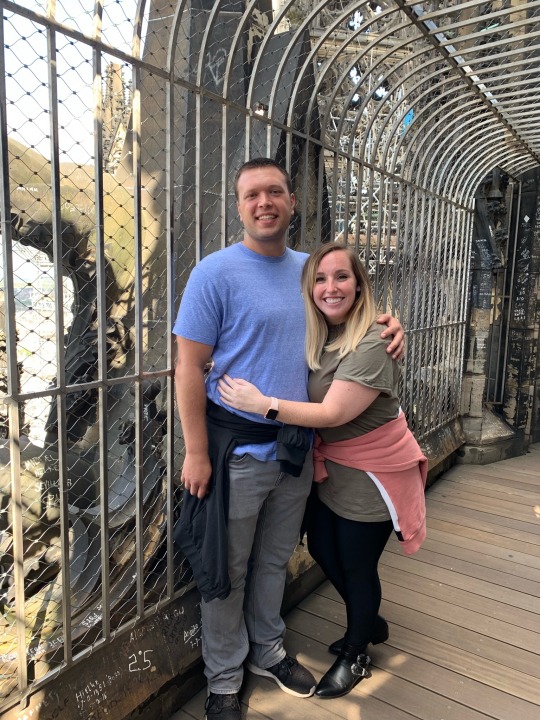





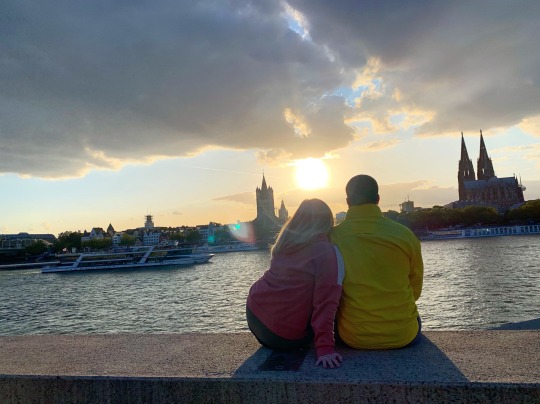

September 18, 2019
Wednesday Ingvar and I woke up around 8 in Dortmund. I had packed and organized most of our stuff the night before, so getting ready was easy. We wore comfy clothes for the train, and left before 9 for the HBF. We took the same metro to the HBF and got some breakfast. We shared a coffee and I got a super tasty chocolate croissant and Ingvar got a sandwich. We waited at our platform for a bit, then our train arrived early.
We were able to get a table with four seats situation, which was super nice! The trip to Cologne (Köln in German) from Dortmund was an hour and 20 minutes. I did my make up and wrote for my blog, while Ingvar snoozed a bit and listened to podcasts. This train didn’t have WiFi, which was a bit of a bummer. We arrived at the main station of Cologne around 11:20. We walked about ten minutes to our hostel, Cologne Downtown Hostel. We past the famous Cologne Cathedral, or Dom (dome). It’s gothic and soooo beautiful. This was actually my third time to Cologne! In 2014, I visited my friend, Franzi, and she took me there for a night with her friends. Last year, I went to Franzi’s wedding, and visited a different friend, Shedya, in Cologne afterwards. And this time we were visiting Sheyda as well!
We didn’t get to check in to our hostel yet, but Ingvar changed and we left all of our bags at the reception. We used the WiFi for a few minutes and decided to meet Sheyda ten minutes away, in Neumarkt. Ingvar and I walked to meet her at the Starbucks. We both got a drink (they had my cool lime refresher! They discontinued it in the US, but I’ve found it a couple times in Europe!). Sheyda met us a few minutes later. It was so good to see her! It was amazing to think that I just visited her last October! It was super nice for her to meet Ingvar! Ingvar means “ginger” in German (but it’s spelt Ingwar, because Germans switch the “w” and “v” sounds in words). It was such a nice day! We decided to walk to the Dom. Sheyda and I had climbed our way to the top last year, and she didn’t want to do it again this time, haha! She needed to run to her University, so Ingvar and I were going to go up on our own. The three of us went into the cathedral, which was massive! Ingvar had never been in a building like it.
If you recall, Sheyda and I had met on a plane from Baku, Azerbaijan to Tbilisi, Georgia, in 2017. She was flying from her hometown, Tehran, Iran. We spent some time in Georgia together, and have kept in touch since. Ingvar and I climbed up the Dom, which was still really hard! It had 533 steps to the top. Ingvar powered through to the top, while I need a few short breaks, so I finished a few minutes later. The steps are in a column, so we wound our way up almost the whole way. The view from the top is absolutely amazing! The day was clear and we had our jackets off from the climb up. We were both sweating. We walked around, enjoying the view for a bit, then headed back down.
I think the way down is easier, but Ingvar things it’s harder, because it hurts his knees. It’s also tricky because we go down the same staircase that we went up, so it’s really tight! We made it outside, where Ingvar recognized someone! Isn’t that crazy? He recognized her voice from working at the bank, but didn’t know her, so we didn’t say hi, haha. We met back up with Sheyda and decided to wander closer to the Rhine River, and grab some lunch. We sat outside with a nice view and had some German food. I wanted to try halve hahn, which is like a German appetizer of bread, veggies, and aged Gouda cheese. Ingvar got fried blood sausage with mashed potatoes, Sheyda got some fried fish and fries, and we were also given some mini buns with a super tasty yogurt dip. The food was tasty! I didn’t love the blood sausage, but Ingvar liked it! We both really loved the Gouda.
After lunch we walked some of the river, and this famous bridge, Hohenzollern Bridge. It has tons of locks on both sides, like the bridges in Paris. It was cool to walk across the Rhine and just chat. We took the metro back across the river and checked into our hostel. The beds weren’t very nice, and there wasn’t a plug by the beds, but the bathroom was much nicer than our hostel in Copenhagen. We got settled in our room and used WiFi for a minute, then met up with Sheyda in the reception.
She wanted to take us to the south part of the city, so we took a bus there. Her and I had been there a year ago! I recognized one of the gates, that used to be part of the city walls. We grabbed a few bottles of kölsh and headed to the river. We sat on some steps and chatted while drinking the local beer. It was pretty windy earlier in the day, but it was nice and sunny, without being too hot. We hung out by the river for a while, then took the bus back to the Heumarkt area, near Neumarkt. We switched to a metro train, then headed back to the “wrong side” of the the Rhine. We found a place called KölnTriangle, to watch the sunset behind the Dom and the city. It was sooo pretty! Sheyda has never done that before, so it was pretty special. Sheyda is just such a special person. She speaks Farsi (Persian), German, and English! And she is just so sweet. She apologized for having such a small room that she couldn’t host us, and paid for some of our lunch when I didn’t have the right cash. She and Ingvar really got along, which was so nice!
After the sun set, she took us to a place for kebob, which is meat rolled into logs and roasted. We took the train to the hipster part of town. We went to Kebapland! It was super packed. Thankfully we got a table. Ingvar and I shared lamb kebob, while Sheyda had a lamb sandwich. They came with rice, a creamy sauce, a spicy sauce, and bread. We also had a typical Turkish drink, called Ayran. It’s a thin, tart, slightly salty, yogurt drink. I had had it before, but this time I liked it better. It was super nice with the flavorful and slightly spicy meat. Ingvar and I paid for dinner, as a thank you to Sheyda, but she didn’t love that haha.
We took the metro back to Neumarkt, close to our hostel. Sheyda came up out of the metro to say goodbye to us outside. I just can’t speak higher of her, she is seriously amazing! We hugged goodbye and she went back to the metro to go back to her dorm, about 20 minutes away.
Ingvar and I walked back to our hostel. It was such a nice, amazing day! I took a hot shower and got ready for bed, while Ingvar watched a soccer game on his phone. Ingvar was on the top bunk this time, heehe, so I was on the bottom, which was nice. I went to bed around 10:30, exhausted but so happy from the last few days. :]
0 notes
Text
Everyday Sustainability
As we all know, Germany is a global leader in sustainability. Us Americans tend to think that it’s all just about how they’re using more renewable energy and that their sustainability is all on a larger level. Actually, more people are using smaller scale techniques to be more eco-friendly. People have their own gardens, they put solar panels on their roofs, they take a bike instead of driving, and they are more conscious about their trash disposal and recycling.
People in Germany seem to be more conscious about their energy consumption. Air conditioning isn’t a very big thing there and when a place does have AC, it isn’t on full blast and won’t make you freeze like in the US. My host family always made sure to turn off everything when they weren’t using it. They would always turn off the lights as soon as they left a room. I noticed that in public bathrooms, people would actually turn off the lights when they would leave. If there wasn’t a light switch, there were motion sensor lights. When I was in Dortmund, the only way that you could use the electricity in your room was to put your room key in a slot. That way, you only used the electricity when you needed it and you weren’t able to leave something running all day because you would have to take your key with you.
There are four different kinds of trash disposal cans for households in Germany: one for compost, one for paper, one for plastic, and one for everything else. I think my host family had all but the compost bin. Recycling is also a little different than in the US. Certain products like glass and plastic bottles and aluminum cans can be returned to the store for money. When you buy one of these products, you pay a small deposit called a pfand. When you return the bottles and cans, you get the deposit back. This is an incentive to get more people to recycle.
Right now, about 30% of Germany’s electricity is powered by renewable energy sources. Of that, 40% of renewable energy is produced by wind turbines and 16% is produced by solar panels (Wikipedia). When we were driving or taking a train through the countryside, there were wind turbines everywhere and quite a few solar fields. These are used to power people’s homes an businesses. I also saw a handful of houses that had their own solar panels on their roofs. We visited a wind turbine and engineers from Enercon gave us a presentation beforehand about their company. The largest turbines they make now have a 4 mega watt generating capacity.

So many wind turbines in the distance in Stößen!

After we got to see the inside of a wind turbine!
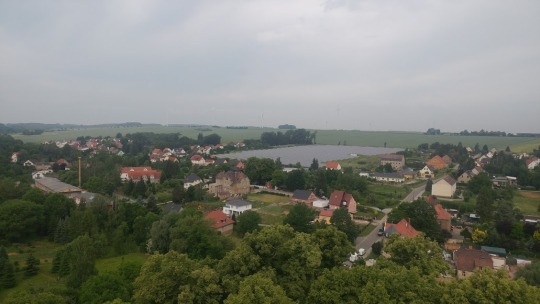
A solar farm in Droyßig taken from the top of the castle.
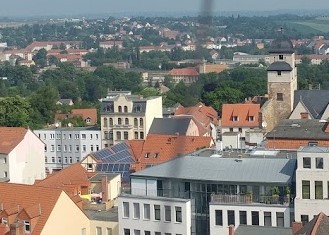
Solar panels on the roofs of houses in Zeitz. Taken from the top of the town hall tower.
Public transportation is so much more common in Germany than in America. Places are less spread out so it makes it a little easier. When we were in Berlin, we walked, took the metro, or took the bus everywhere that we went. Riding a bike is very common. In Berlin and Leipzig, I noticed that they had specific parts of the street or sidewalk just for bicycles. There were bikes everywhere! Though when I went to Amsterdam after this trip, there were significantly more bicycles. In Leipzig, we got to take the streetcar, which has a track right in the middle of the roads where a median would normally be. That was fun, I’ve really only seen streetcars in Cincinnati and Charlotte back home. Then whenever we had to travel a long distance between cities, we would take the train. Their rail system in Europe is much more efficient than in the US. When I took the train from Berlin to Dortmund, it was only $60 to do so. But whenever I’ve looked up Amtrak tickets to go from Columbia to DC, they were over $200. Their trains also travel very quickly. My train to Dortmund had a speedometer that the passengers could see and it reached speeds over 200 km/h.

Multiple bike racks outside of a bank in Leipzig.
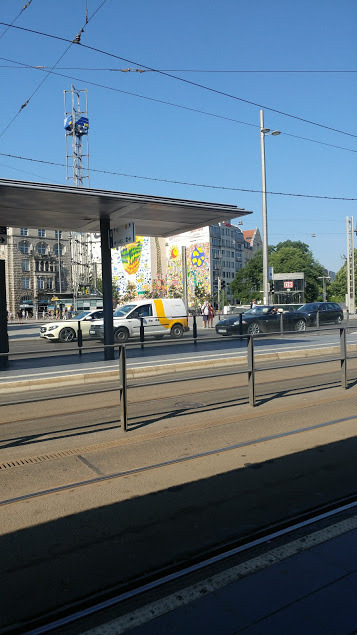
This is the street car track in front of the train station in Leipzig.
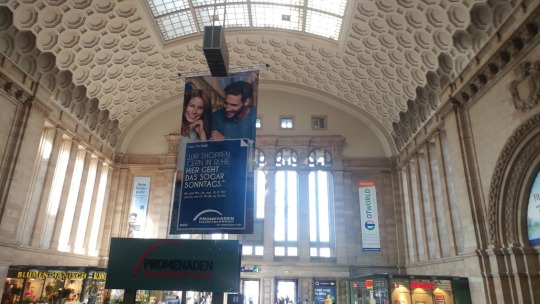
Inside the entrance of the train station in Leipzig.
People in Germany have more produce gardens than people in the US. Schrebergartens are very popular with German citizens. They’re allotments away from their home where they can plant fruits and vegetables and most have a little building that have electricity so that they can be used as like a cottage almost. When I was in Weißenfels, Aylin and I went to see her friend Amon. The first day we hung out with him was at his family’s garden which was probably a mile away from their apartment. I actually thought that this was where they lived when we got there because the yard was huge! They had a giant garden, a pool, a patio with a grill, a playground, and a little house that had electricity and a bathroom. I feel like allotment gardens should be more popular in the US, especially because a lot of people live in apartments and don’t have a yard to grow produce in. For those who don’t have their own garden, all of the towns we visited have a marketplace in the center. When we visited Quedlinburg and Leipzig, there were a bunch of local farmers selling their produce.

A little garden on someone’s front porch in Zeitz.

A garden in a courtyard in Berlin.

A local market in Quedlinburg.
Overall, I noticed that people in Germany tend to be more sustainable than the people in the United States. Seeing how people are more aware of their impact on the Earth makes me want to try to implement more sustainable practices into my everyday life. I’m definitely going to go and try to start growing an herb garden when I get back to Columbia.
0 notes
Text
Apple has signed a partnership with Ito World so as to add bike-sharing information in Apple Maps in over 175 towns throughout 36 international locations. The characteristic is now reside and is helping you in finding the nearest station by means of typing “bike sharing” in the seek bar or the identify of the carrier.
Once once more, Apple selected to combine an present information set as a substitute of placing in combination this knowledge in-house. Ito World has labored with dozens of businesses to license and normalize bike-sharing information. This approach, Apple handiest has to combine one information type to improve loads of bike-sharing products and services.
Apple isn’t ranging from 0 as the corporate had already built-in some bike-sharing information in a handful of towns. But it is a giant growth over present information.
Apple Maps doesn’t inform you the collection of to be had motorcycles or empty docks. I am hoping the corporate goes so as to add this in an upcoming replace. It simply offers you the deal with, identify and phone data for the carrier, so this option received’t exchange extra refined apps for native customers.
But it may be moderately helpful if you’re touring to some other town and you need to experience a motorbike. As the identify of the carrier is other in every town, you steadily finally end up on Google in search of native bike-sharing products and services.
With this replace, you can sort “bike sharing” in any town and in finding the identify of the carrier and the location of the closest station. It doesn’t inform you if a startup is working a dock-less bike-sharing carrier in that town. So you’ll must open the Mobike, Ofo or oBike app your self.
Apple Maps helps Citi Bike in NYC, Ford CrossBike in San Francisco, BIKETOWN in Portland, Santander Cycles in London, bicing in Barcelona, BIXI in Montreal, CityCycle in Brisbane, nextbike in Germany, Austria, Croatia, Switzerland, the U.Okay., and dozens of others. I attempted in search of stations in smaller towns and it additionally works in European towns with loads of hundreds of other folks.
Apple has been slowly including extra information to Apple Maps to stick related in opposition to Google Maps. The app now helps airport and mall maps, lane steering, public transit, EV charging stations and extra. Your mileage might range, however Apple Maps may now be a just right possibility in your native space.
Update: Here’s the complete listing of supported products and services. It represents 176 products and services in 179 towns in overall.
ANZ:
Australia
Brisbane (CityCycle)
Monash University (Monash Bikeshare)
New Zealand
Auckland (nextbike Auckland)
Christchurch (nextbike Christchurch)
Europe:
Austria
10vorWien (nextbike 10vorWien)
Amstetten (nextbike Amstetten)
Innsbruck (stadtrad Innsbruck)
Klagenfurt (nextbike Klagenfurt)
Lunz am See (nextbike Lunz am See)
Mödling (nextbike Mödling)
NeusiedlerSee (nextbike Neusiedler See)
Römerland (nextbike Römerland)
Serfaus (nextbike Serfaus)
St.Pölten (nextbike St.Polten)
Thermenregion (nextbike Thermenregion)
Traisen-Gölsental (nextbike Traisen-Gölsental)
Triestingtal (nextbike Triestingtal)
Tulln (nextbike Tulln)
Unteres Traisental (nextbike Unteres Traisental)
Vienna (citybike Wien)
Wiener Neustadt (nextbike Wiener Neustadt)
Wiener Wald (nextbike Wiener Wald)
Belgium
Antwerp (A velo)
Brussels (Villo!)
Namur (Li bia velo)
Bosnia and Herzegovina
Sarajevo (nextbike BiH)
Croatia
Brinje (nextbike Brinje)
Gospić (nextbike Gospić)
Ivanic Grad (nextbike Ivanic Grad)
Karlovac (nextbike Karlovac)
Makarska (nextbike Makarsa)
Šibenik (nextbike Sibenik)
Zadar (nextbike Zadar)
Zagreb (nextbike Zagreb)
Cyprus
Limassol (nextbike Limassol)
Estonia
Tallinn (SIXT Tallinn)
Finland
Helsinki (alepa Fillari)
France
Amiens (Velam)
Besançon (Vélocité Besançon)
Cergy-Pontoise (VélO2)
Créteil (Cristolib)
Lille (V lille)
Lyon (Vélo’V)
Marseille (le vélo)
Mulhouse (Vélocité Mulhouse)
Nancy (vélOstan’lib)
Nantes (Bicloo)
Paris (Velib)
Rouen (Cy’clic)
Toulouse (Vélô Toulouse)
Germany
Augsburg (swa Rad Augsburg)
Bensheim (VRNnextbike Bensheim)
Berlin (nextbike Berlin)
Bochum (metropolradruhr Bochum)
Bottrop (metropolradruhr Bottrop)
Cologne (KVB rad)
Dortmund (metropolradruhr Dortmund)
Dresden (sz-bike)
Duisburg (Metropolradruhr Duisburg)
Düsseldorf (nextbike Dusseldorf)
Essen (metropolradruhr Essen)
Flensburg (nextbike Flensburg)
Frankfurt (nextbike Frankfurt)
Gelsenkirchen (metropolradruhr Gelsenkirchen)
Gütersloh (nextbike Gutersloh)
Hamburg (nextbike Hamburg)
Hamm (metropolradruhr Hamm)
Heidelberg (VRNnextbike Heidelberg)
Herne (metropolradruhr Herne)
Karlsruhe (Fächerrad)
Leipzig (nextbike Leipzig)
Ludwigshafen (VRNnextbike Ludwigshafen)
Magdeburg (nextbike Magdeburg)
Mannheim (VRNnextbike Mannheim)
Mülheim a.d.R. (metropolradruhr Muelheim)
München (nextbike Munchen)
Norderstedt (nextbike Norderstedt)
Nürnberg (NorisBike)
Oberhausen (metropolradruhr Oberhausen)
Offenburg (nextbike Offenburg)
Potsdam (nextbike Potsdam)
Quickborn (nextbike Quickborn)
Schorndorf (e-bike-stationen Schorndorf)
Schwieberdingen (e motorcycle stationen Schwieberdingen)
Speyer (VRNnextbike Speyer)
Südheide (nextbike Südheide)
Tübingen (nextbike Tübingen)
Usedom (useDomraD)
Wachau (nextbike Wachau)
Würzburg (nextbike Wuerzburg)
Hungary
Budapest (bubi)
Ireland
Cork (Coca-Cola 0 Cork)
Dublin (dublinbikes)
Galway (Coca-Cola 0 Galway)
Limerick (Coca-Cola 0 Limerick)
Latvia
Jūrmala (SIXT Jūrmala)
Rīga (SiXT Riga)
Lebanon
Byblos (Bike four All Byblos)
Lithuania
Vilnius (Cyclocity)
Luxembourg
Luxembourg (Veloh)
Malta
Malta (nextbike Malta)
Netherlands
Maastricht (nextbike Maastricht)
Norway
Lillestrøm (Bysykkel)
Oslo (Oslo City Bike)
Poland
Białystok (BiKeR)
Gliwice (GliwickiRowerMiejski)
Grodzisk Mazowiecki (Grodziski Rower Miejski)
Katowice (CityBy way ofBike)
Konstancin Jeziorna (Konstanciński Rower Miejski)
Lódź (Łódzki Rower Publiczny)
Lublin (Lubelski Rower Miejski Lublin)
Michałowice (Rower Gminny)
Opole (nextbike Opole)
Poznan (Poznański Rower Miejski)
Radom (Radomski Rower Miejski)
Warszawa (VETURILO Stacje Sponsorskie)
Stalowa Wola (STALOWA WOLA MIASTO ROWEROW)
Świdnik (Lubelski Rower Miejski Świdnik)
Szczecin (Bike_s Szczecin)
Warszawa (Veturilo)
Wrocław (Wrocławski Rower Miejski)
Russia
Kazan (Veli’okay)
Slovenia
Ljubljana (Bicikelj)
Spain
Barcelona (bicing)
Seville (SEVici)
Valencia (Valenbisi)
Zaragoza (Bizi Zaragoza)
Sweden
Gothenburg (Styr & Ställ)
Lund (Lundahoj)
Switzerland
Hergiswil (nextbike Hergiswil)
Luzern (nextbike Luzern)
Stans (nextbike Stans)
Stansstad (nextbike Stansstad)
Sursee (nextbike Sursee)
Turkey
Konya (nextbike Konya)
Seferihisar (Karbis)
Ukraine
Lviv (nexbike Lviv)
United Kingdom
Bath (nextbike Bath)
Belfast (Coca-Cola Zero Belfast Bikes)
Exeter (co motorcycles)
Glasgow (nextbike Glasgow)
London (Santander Cycles)
Milton Keynes (Santander Cycles MK)
Stirling (nextbike Stirling)
University of Warwick (UniCycles)
North America:
Canada
Hamilton (sobi Hamilton)
Montreal (BIXI)
USA
Atlanta (Relay)
Boise (Boise Greenbike)
Boston (Hubway)
Buffalo (REDDY bikeshare)
Charlottesville (UBike)
Chicago (Divvy)
Columbus, OH (CoGo Bike Share)
Hoboken (Hudson Bike Share)
Kent State University (Flashfleet)
Ketchum / Sun Valley (MR BIKE SHARE)
Long Beach (sobi LONG BEACH)
New York (citi motorcycle)
Phoenix (GR:D)
Pittsburgh (Healthy Ride)
Portland (BIKETOWN)
San Francisco Bay Area (Ford CrossBike)
San Ramon (BRiteBikes)
St. Paul (nICE RIDE Minnesota)
Topeka (Topeka Metro Bikes)
Washington (Capital Bikeshare)
West Palm Beach (SKYBIKE)
Tampa, St Petersburg and USF (coast)
Orlando (Juice)
Santa Monica (Breeze Bike Share)
Middle East / Asia:
India
Bhopal (Chartered Bike Bhopal)
Kuwait
Kuwait City (ByKy Kuwait)
Saudi Arabia
King Abdullah Economic City (I-Bike)
UAE
Dubai (Byky Dubai)
Al Ain (Byky Al Ain)
Apple Maps shows you the nearest bike-sharing stations – TechCrunch
Apple has signed a partnership with Ito World so as to add bike-sharing information in Apple Maps in over 175 towns throughout 36 international locations.
Apple Maps shows you the nearest bike-sharing stations – TechCrunch Apple has signed a partnership with Ito World so as to add bike-sharing information in Apple Maps in over 175 towns throughout 36 international locations.
0 notes
Text
Apple has signed a partnership with Ito World so as to add bike-sharing information in Apple Maps in over 175 towns throughout 36 international locations. The characteristic is now reside and is helping you in finding the nearest station by means of typing “bike sharing” in the seek bar or the identify of the carrier.
Once once more, Apple selected to combine an present information set as a substitute of placing in combination this knowledge in-house. Ito World has labored with dozens of businesses to license and normalize bike-sharing information. This approach, Apple handiest has to combine one information type to improve loads of bike-sharing products and services.
Apple isn’t ranging from 0 as the corporate had already built-in some bike-sharing information in a handful of towns. But it is a giant growth over present information.
Apple Maps doesn’t inform you the collection of to be had motorcycles or empty docks. I am hoping the corporate goes so as to add this in an upcoming replace. It simply offers you the deal with, identify and phone data for the carrier, so this option received’t exchange extra refined apps for native customers.
But it may be moderately helpful if you’re touring to some other town and you need to experience a motorbike. As the identify of the carrier is other in every town, you steadily finally end up on Google in search of native bike-sharing products and services.
With this replace, you can sort “bike sharing” in any town and in finding the identify of the carrier and the location of the closest station. It doesn’t inform you if a startup is working a dock-less bike-sharing carrier in that town. So you’ll must open the Mobike, Ofo or oBike app your self.
Apple Maps helps Citi Bike in NYC, Ford CrossBike in San Francisco, BIKETOWN in Portland, Santander Cycles in London, bicing in Barcelona, BIXI in Montreal, CityCycle in Brisbane, nextbike in Germany, Austria, Croatia, Switzerland, the U.Okay., and dozens of others. I attempted in search of stations in smaller towns and it additionally works in European towns with loads of hundreds of other folks.
Apple has been slowly including extra information to Apple Maps to stick related in opposition to Google Maps. The app now helps airport and mall maps, lane steering, public transit, EV charging stations and extra. Your mileage might range, however Apple Maps may now be a just right possibility in your native space.
Update: Here’s the complete listing of supported products and services. It represents 176 products and services in 179 towns in overall.
ANZ:
Australia
Brisbane (CityCycle)
Monash University (Monash Bikeshare)
New Zealand
Auckland (nextbike Auckland)
Christchurch (nextbike Christchurch)
Europe:
Austria
10vorWien (nextbike 10vorWien)
Amstetten (nextbike Amstetten)
Innsbruck (stadtrad Innsbruck)
Klagenfurt (nextbike Klagenfurt)
Lunz am See (nextbike Lunz am See)
Mödling (nextbike Mödling)
NeusiedlerSee (nextbike Neusiedler See)
Römerland (nextbike Römerland)
Serfaus (nextbike Serfaus)
St.Pölten (nextbike St.Polten)
Thermenregion (nextbike Thermenregion)
Traisen-Gölsental (nextbike Traisen-Gölsental)
Triestingtal (nextbike Triestingtal)
Tulln (nextbike Tulln)
Unteres Traisental (nextbike Unteres Traisental)
Vienna (citybike Wien)
Wiener Neustadt (nextbike Wiener Neustadt)
Wiener Wald (nextbike Wiener Wald)
Belgium
Antwerp (A velo)
Brussels (Villo!)
Namur (Li bia velo)
Bosnia and Herzegovina
Sarajevo (nextbike BiH)
Croatia
Brinje (nextbike Brinje)
Gospić (nextbike Gospić)
Ivanic Grad (nextbike Ivanic Grad)
Karlovac (nextbike Karlovac)
Makarska (nextbike Makarsa)
Šibenik (nextbike Sibenik)
Zadar (nextbike Zadar)
Zagreb (nextbike Zagreb)
Cyprus
Limassol (nextbike Limassol)
Estonia
Tallinn (SIXT Tallinn)
Finland
Helsinki (alepa Fillari)
France
Amiens (Velam)
Besançon (Vélocité Besançon)
Cergy-Pontoise (VélO2)
Créteil (Cristolib)
Lille (V lille)
Lyon (Vélo’V)
Marseille (le vélo)
Mulhouse (Vélocité Mulhouse)
Nancy (vélOstan’lib)
Nantes (Bicloo)
Paris (Velib)
Rouen (Cy’clic)
Toulouse (Vélô Toulouse)
Germany
Augsburg (swa Rad Augsburg)
Bensheim (VRNnextbike Bensheim)
Berlin (nextbike Berlin)
Bochum (metropolradruhr Bochum)
Bottrop (metropolradruhr Bottrop)
Cologne (KVB rad)
Dortmund (metropolradruhr Dortmund)
Dresden (sz-bike)
Duisburg (Metropolradruhr Duisburg)
Düsseldorf (nextbike Dusseldorf)
Essen (metropolradruhr Essen)
Flensburg (nextbike Flensburg)
Frankfurt (nextbike Frankfurt)
Gelsenkirchen (metropolradruhr Gelsenkirchen)
Gütersloh (nextbike Gutersloh)
Hamburg (nextbike Hamburg)
Hamm (metropolradruhr Hamm)
Heidelberg (VRNnextbike Heidelberg)
Herne (metropolradruhr Herne)
Karlsruhe (Fächerrad)
Leipzig (nextbike Leipzig)
Ludwigshafen (VRNnextbike Ludwigshafen)
Magdeburg (nextbike Magdeburg)
Mannheim (VRNnextbike Mannheim)
Mülheim a.d.R. (metropolradruhr Muelheim)
München (nextbike Munchen)
Norderstedt (nextbike Norderstedt)
Nürnberg (NorisBike)
Oberhausen (metropolradruhr Oberhausen)
Offenburg (nextbike Offenburg)
Potsdam (nextbike Potsdam)
Quickborn (nextbike Quickborn)
Schorndorf (e-bike-stationen Schorndorf)
Schwieberdingen (e motorcycle stationen Schwieberdingen)
Speyer (VRNnextbike Speyer)
Südheide (nextbike Südheide)
Tübingen (nextbike Tübingen)
Usedom (useDomraD)
Wachau (nextbike Wachau)
Würzburg (nextbike Wuerzburg)
Hungary
Budapest (bubi)
Ireland
Cork (Coca-Cola 0 Cork)
Dublin (dublinbikes)
Galway (Coca-Cola 0 Galway)
Limerick (Coca-Cola 0 Limerick)
Latvia
Jūrmala (SIXT Jūrmala)
Rīga (SiXT Riga)
Lebanon
Byblos (Bike four All Byblos)
Lithuania
Vilnius (Cyclocity)
Luxembourg
Luxembourg (Veloh)
Malta
Malta (nextbike Malta)
Netherlands
Maastricht (nextbike Maastricht)
Norway
Lillestrøm (Bysykkel)
Oslo (Oslo City Bike)
Poland
Białystok (BiKeR)
Gliwice (GliwickiRowerMiejski)
Grodzisk Mazowiecki (Grodziski Rower Miejski)
Katowice (CityBy way ofBike)
Konstancin Jeziorna (Konstanciński Rower Miejski)
Lódź (Łódzki Rower Publiczny)
Lublin (Lubelski Rower Miejski Lublin)
Michałowice (Rower Gminny)
Opole (nextbike Opole)
Poznan (Poznański Rower Miejski)
Radom (Radomski Rower Miejski)
Warszawa (VETURILO Stacje Sponsorskie)
Stalowa Wola (STALOWA WOLA MIASTO ROWEROW)
Świdnik (Lubelski Rower Miejski Świdnik)
Szczecin (Bike_s Szczecin)
Warszawa (Veturilo)
Wrocław (Wrocławski Rower Miejski)
Russia
Kazan (Veli’okay)
Slovenia
Ljubljana (Bicikelj)
Spain
Barcelona (bicing)
Seville (SEVici)
Valencia (Valenbisi)
Zaragoza (Bizi Zaragoza)
Sweden
Gothenburg (Styr & Ställ)
Lund (Lundahoj)
Switzerland
Hergiswil (nextbike Hergiswil)
Luzern (nextbike Luzern)
Stans (nextbike Stans)
Stansstad (nextbike Stansstad)
Sursee (nextbike Sursee)
Turkey
Konya (nextbike Konya)
Seferihisar (Karbis)
Ukraine
Lviv (nexbike Lviv)
United Kingdom
Bath (nextbike Bath)
Belfast (Coca-Cola Zero Belfast Bikes)
Exeter (co motorcycles)
Glasgow (nextbike Glasgow)
London (Santander Cycles)
Milton Keynes (Santander Cycles MK)
Stirling (nextbike Stirling)
University of Warwick (UniCycles)
North America:
Canada
Hamilton (sobi Hamilton)
Montreal (BIXI)
USA
Atlanta (Relay)
Boise (Boise Greenbike)
Boston (Hubway)
Buffalo (REDDY bikeshare)
Charlottesville (UBike)
Chicago (Divvy)
Columbus, OH (CoGo Bike Share)
Hoboken (Hudson Bike Share)
Kent State University (Flashfleet)
Ketchum / Sun Valley (MR BIKE SHARE)
Long Beach (sobi LONG BEACH)
New York (citi motorcycle)
Phoenix (GR:D)
Pittsburgh (Healthy Ride)
Portland (BIKETOWN)
San Francisco Bay Area (Ford CrossBike)
San Ramon (BRiteBikes)
St. Paul (nICE RIDE Minnesota)
Topeka (Topeka Metro Bikes)
Washington (Capital Bikeshare)
West Palm Beach (SKYBIKE)
Tampa, St Petersburg and USF (coast)
Orlando (Juice)
Santa Monica (Breeze Bike Share)
Middle East / Asia:
India
Bhopal (Chartered Bike Bhopal)
Kuwait
Kuwait City (ByKy Kuwait)
Saudi Arabia
King Abdullah Economic City (I-Bike)
UAE
Dubai (Byky Dubai)
Al Ain (Byky Al Ain)
Apple Maps shows you the nearest bike-sharing stations – TechCrunch Apple has signed a partnership with Ito World so as to add bike-sharing information in Apple Maps in over 175 towns throughout 36 international locations.
0 notes
Text

ph. Danko Maksimovic - Dortmund, Germany (2023)
Film: Kodak Portra 800
#film photography#analog photography#kodak portra 800#dortmund metro station#metro station#danko maksimovic#dankomaksimovic#neon aesthetic#neon lights#35mm photography#35mm film
66 notes
·
View notes
Text
Entertainment, architectural, and football Includes: North Rhine-Westphalia - #BorussiaDortmund, #Carnivals, #Cologne, #Dortmund, #Duisburg, #Dusseldorf, #Essen, #Europe, #FCSchalke04, #Galatasaray, #German, #Germans, #Germany, #Thyssenkrupp, #Turkish
New Post has been published on http://justforustravel.com/2017/10/06/entertainment-architectural-and-football-includes-north-rhine-westphalia/
Entertainment, architectural, and football Includes: North Rhine-Westphalia
previously, North Rhine-Westphalia in the area I’ve ever been to. This region, especially from Turkey, a place where concentrations of people live. I’m starting to explore here starting from the first day I set my foot in. Discover my purpose in coming here anyway-is just out, isn’t it? Every inch of this walking around and opening my eyes and I’m looking around. Went across in the industry almost 50 years ago in Germany cities in Germany that makes leadership feel it in my bones. Not only that! In this area, entertainment, architectural, and football in life. The most beautiful part. The cities of these structures, time to explore with my camera in my hand…
Dusseldorf
the capital and major economic centre of Germany’s North Rhine-Westphalia, Dusseldorf, carnivals, night life, fashion Star is shining with its central location. The edge of the River Rhine, the Altstadt the center of the city immediately. Altstadt, II. A territory that has been flattened in World War II. Currently traditional German bars and restaurants seem to congregate here. By entering into any of the bars German myself, I’m putting for the traditional black beer. In total 260 square kilometers Altstadt an understated bar, cafeteria. In many parts of the city, the statues and monuments that you come across when you least expect it and is very impressive. Friendly sculptures to keep my head up, I’m watching with my mouth hanging open.
Cologne
Westphalia’s largest city Cologne, Germany’s fourth largest. North Rhine-Westphalia tourism, media and economy in central city, with festivals, architectural structures, and stands out. The Carnival of Cologne adds a special beauty to the city. A tough competition between Dusseldorf and Cologne is actually related to the carnival is experiencing. The people of the region would be blessed to celebrate Carnival in the month of November and February that is divided into two parts. I’m so lucky that I’ve been Carnival time here. Cold and harsh with the wrong side of the people I know they would have fun at the Carnival and I saw they could be friendly. Given concerts at many points during the Carnival. The Carnival of the city is felt at every point. The impressive architecture of the city, while having fun, on the other hand, the huge edifice in front of the Cathedral Kölner Dom so. Carnival also already starts here. Also the Hohenzollern Bridge are also worth a visit in the city. For a bit of privacy, The Botanic Garden may be preferred. Spoken in the finest flowers in the world information panel here.
Essen
you may be hearing for the first time the name of Essen, Essen over a point but I want to talk about. ‘Thyssenkrupp‘ name, especially living in Istanbul is definitely one. This company is one of Germany’s and the world’s major steel producers. Manufacturer of metro escalators to the mall in Turkey in many areas. If you look at the escalator, ‘ThyssenKrupp you will see. The city, you should visit to see the effects of Nazi Germany. Of course, millions of workers and has run for themselves, private homes, entertainment areas, living centers established. These centers are built to order and how you come here to be a witness! I lived here during the time I worked for the newspaper waz. There is a side of town nice and quiet. Homesickness also, you don’t have either on your trip short. ‘The state köfteci raw, Barber, shawarma joint about the kebab, the grocery store is no stranger to you. So sometimes yourself Turkey entry Sanabilirsiz h at 80.
Duisburg
Westfalia’s steel Trade Center, Duisburg, 20. the most obvious examples of the disciplines in the middle of the century showing German business, il he appeared in. City of Industry, each mine or in the factory at the time in 100 thousands of people he was working for. This is for the employees and residential areas, entertainment venues and living centers established. Even today, it is possible to see these structures, but many building II. It was destroyed in World War II. Across the remaining buildings, a museum, a restaurant and a cafeteria, it turns out to be. Duisburg is the point that surprised me: people have gathered here from Turkey to Germany in time. Such a structure is formed so that with time a single address for the wedding of people of Turkish origin here in Duisburg. Just from Germany, Turkey from many cities of Europe is coming to this city for the wedding of the exchange of origin.
Dortmund
there is a pleasant side of Dortmund. Especially ‘soccer fan’ if you’re not, this city needs you. With are split between FC Schalke 04, Borussia Dortmund zone. The city of Dortmund, as its name suggests, the ‘dark’ Borussia supporters. Here is my first visit and Borussia – Galatasaray match. Stat I can find a ticket to watch the game mean the Alter Markt Square, together with the Germans I watched. I was late in getting tickets, or ticket prices are very reasonable here, 60 euros. Since the town is so small, a very pleasant city with the bike, type can be made. So what I’m doing. Stop by the stalls in several points of the city bicycles for rent. A credit card and a mobile phone number is sufficient. You can start exploring from the train station in holzwicke dormtund. Also the world’s tallest Christmas tree on Christmas Day was also established there. If you’re on your way out for Christmas, so you should definitely try mulled wine gluhwein.
#Borussia Dortmund#carnivals#Cologne#Dortmund#Duisburg#Dusseldorf#Essen#Europe#FC Schalke 04#Galatasaray#German#Germans#Germany#Thyssenkrupp#Turkish
0 notes
Text
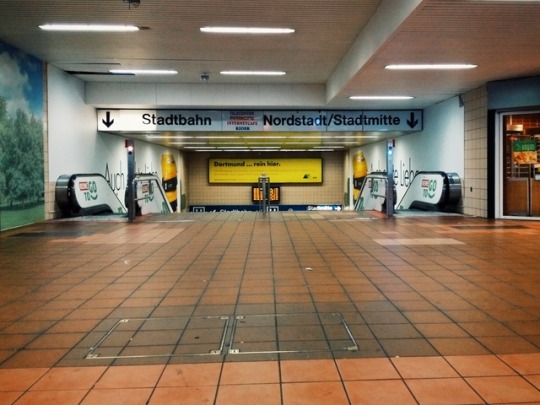
#photographers on tumblr#original photographers#snapseed#ruhrpott#ruhrgebiet#dortmund#mobile#original content#photography#architecture#train station#hbf#metro#station#sign#empty
15 notes
·
View notes
Text

#photographers on tumblr#original photographers#snapseed#ruhrgebiet#dortmund#mobile#original content#photography#metro#station#escalator#colorful#city#lighting#mobile phone#stadtgarten#ubahn
8 notes
·
View notes
Text

#photographers on tumblr#original photographers#snapseed#ruhrgebiet#ruhrpott#dortmund#mobile#original content#metro#station#saarlandstraße#city#kreuzviertel#metro station#mobile phone#ubahn
4 notes
·
View notes
Photo
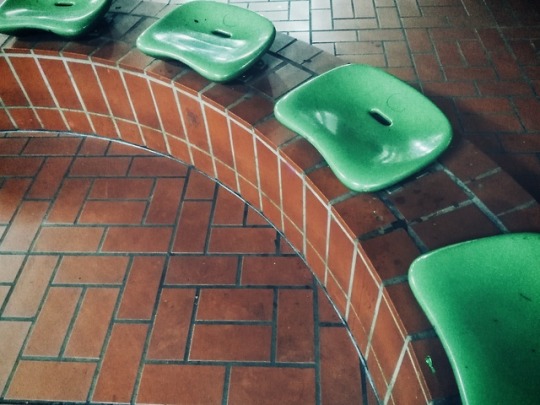
#dortmund#stadtgarten#metro#station#bench#seats#green#plastic#brick#abstract#mobile#snapseed#ruhrgebiet#original photographers#photographers on tumblr
4 notes
·
View notes
Photo

#dortmund#metro#station#ruhrgebiet#tiles#blue#mobile#snapseed#original photographers#photographers on tumblr
4 notes
·
View notes